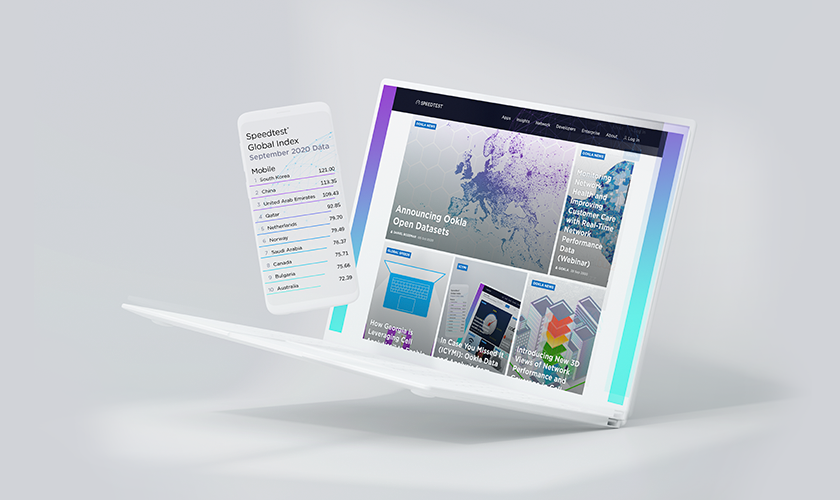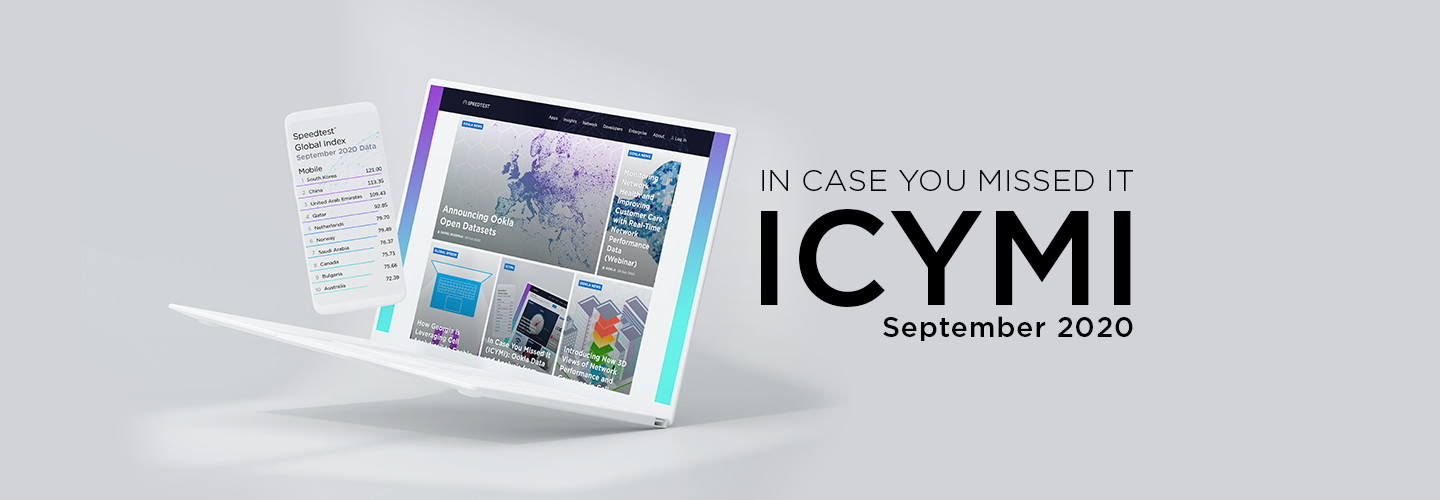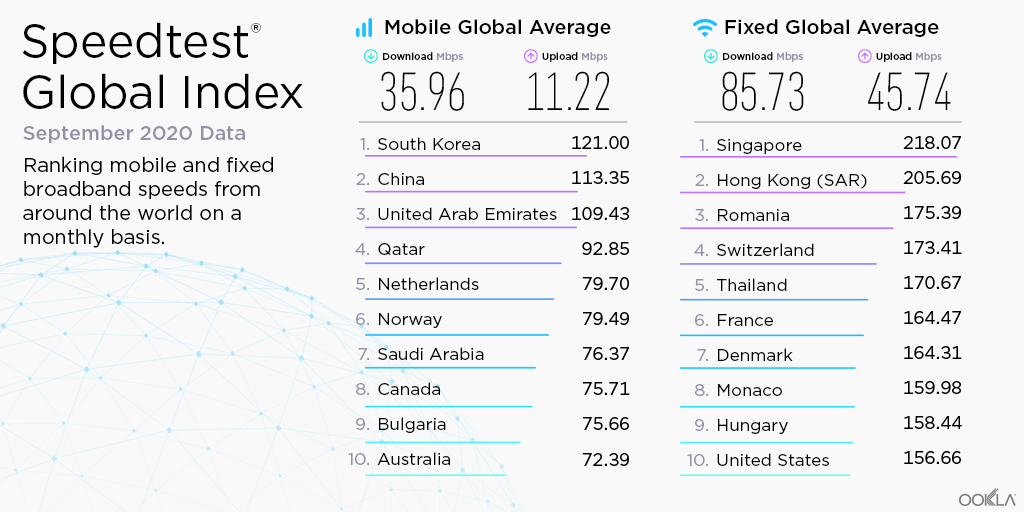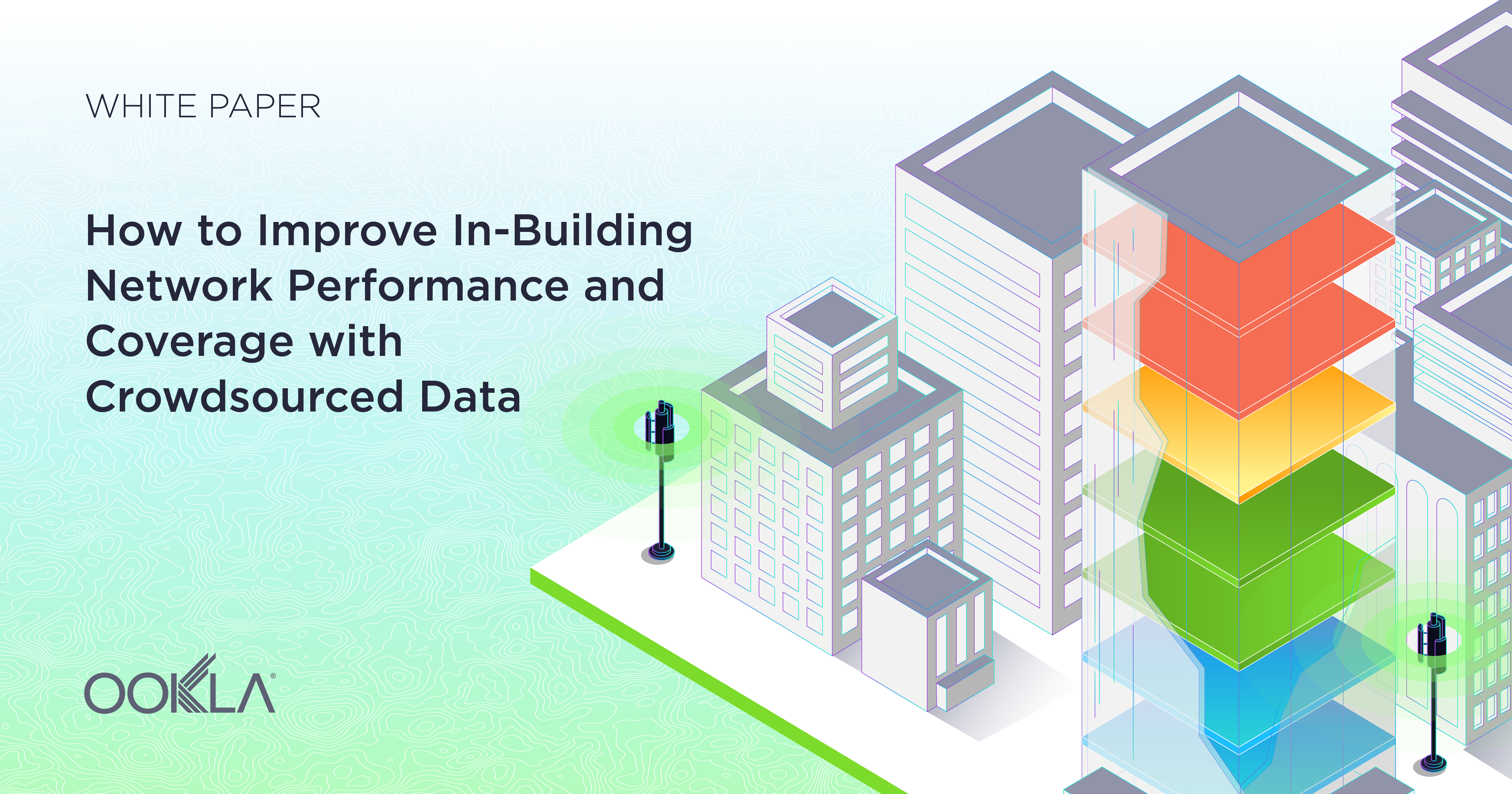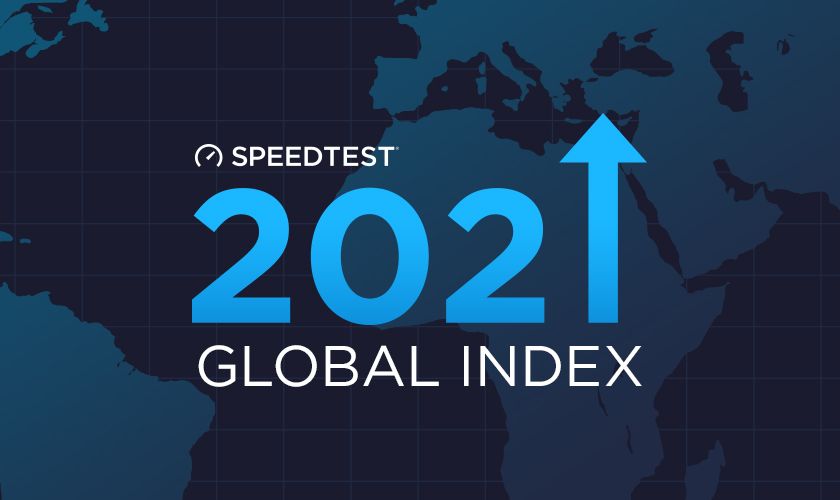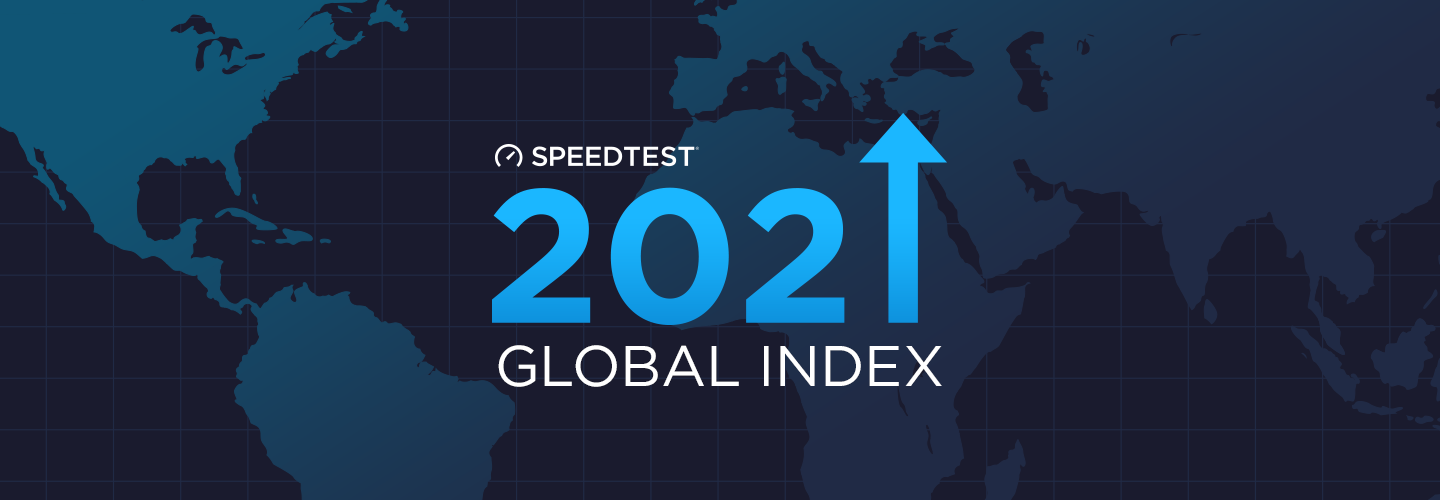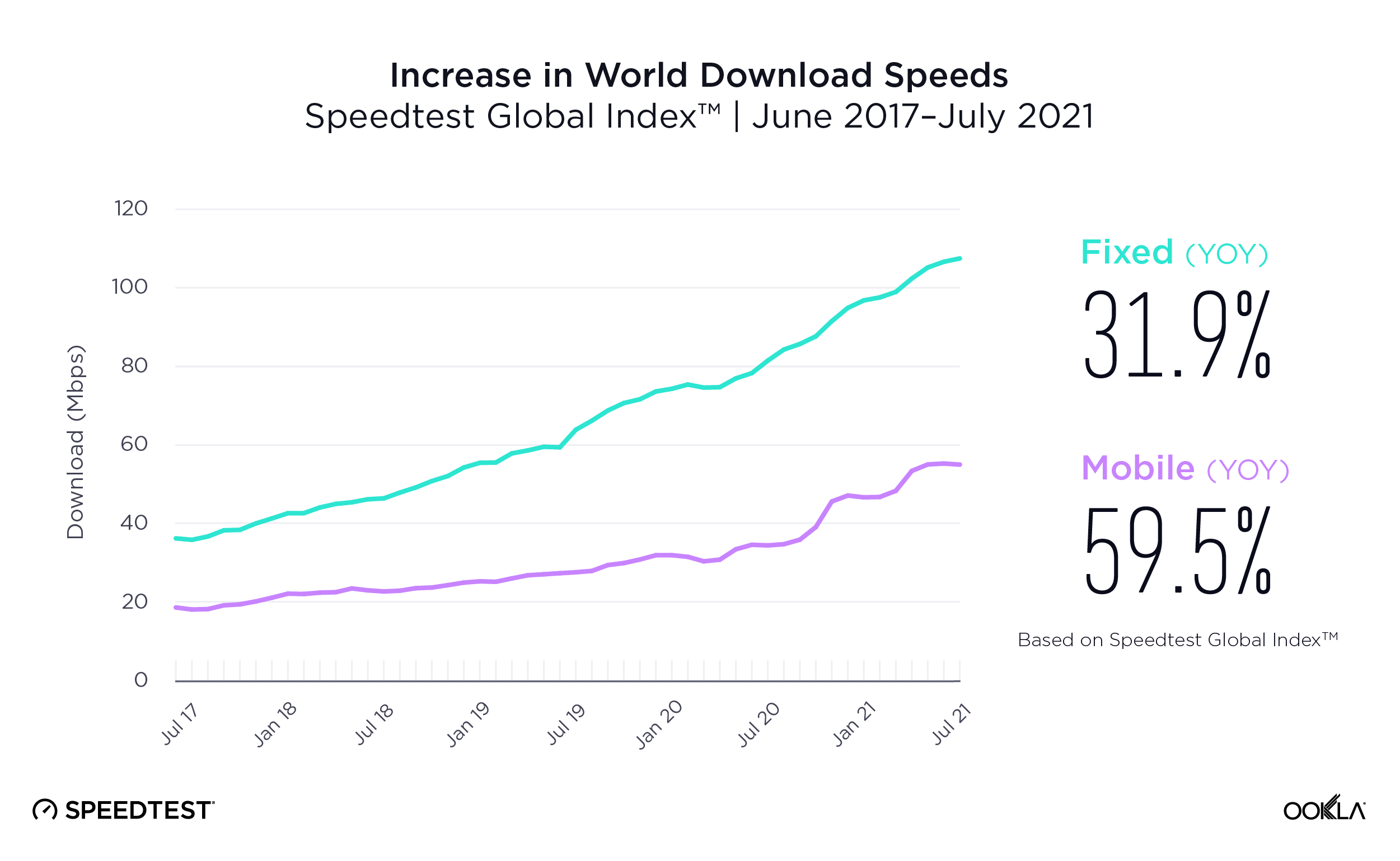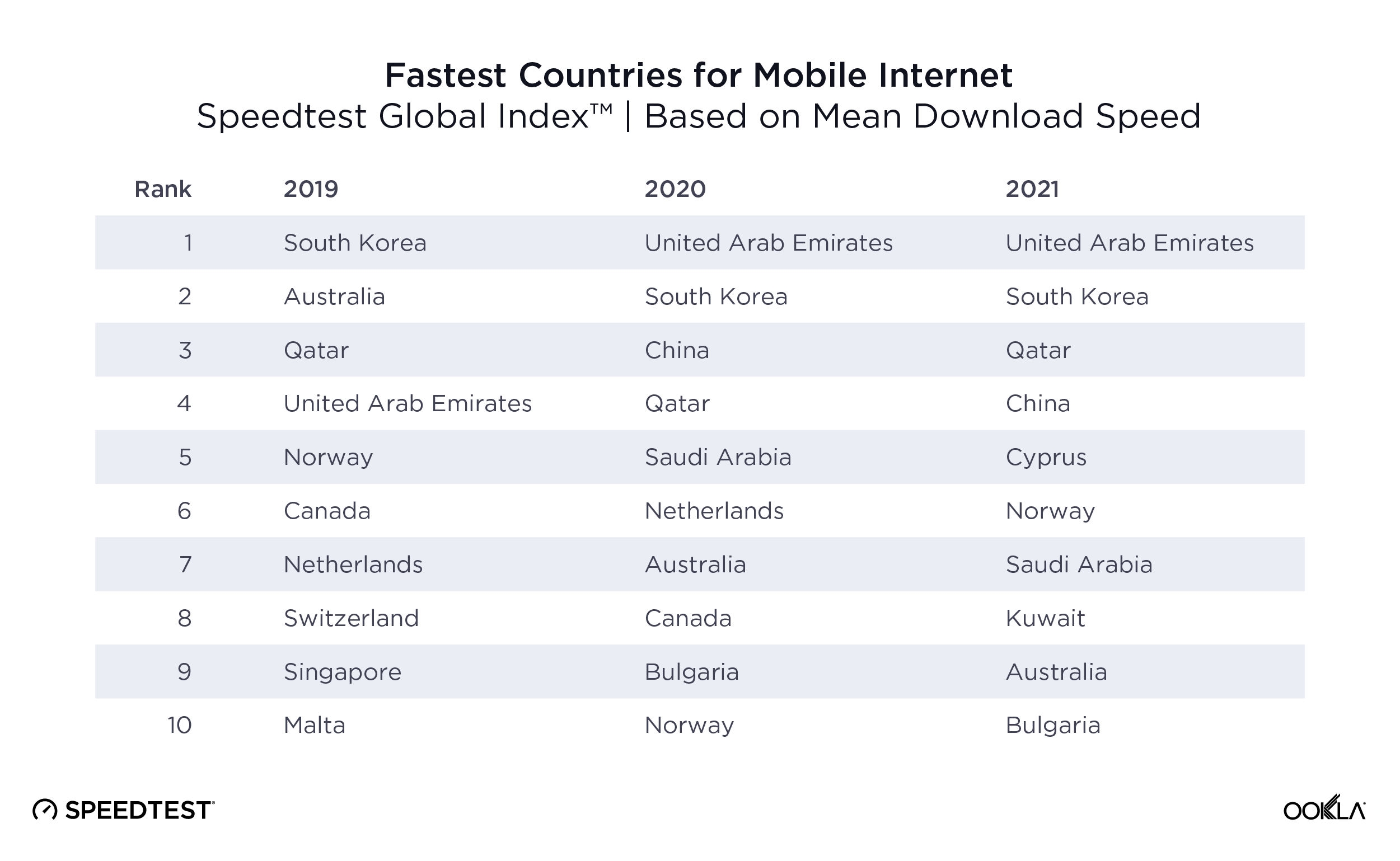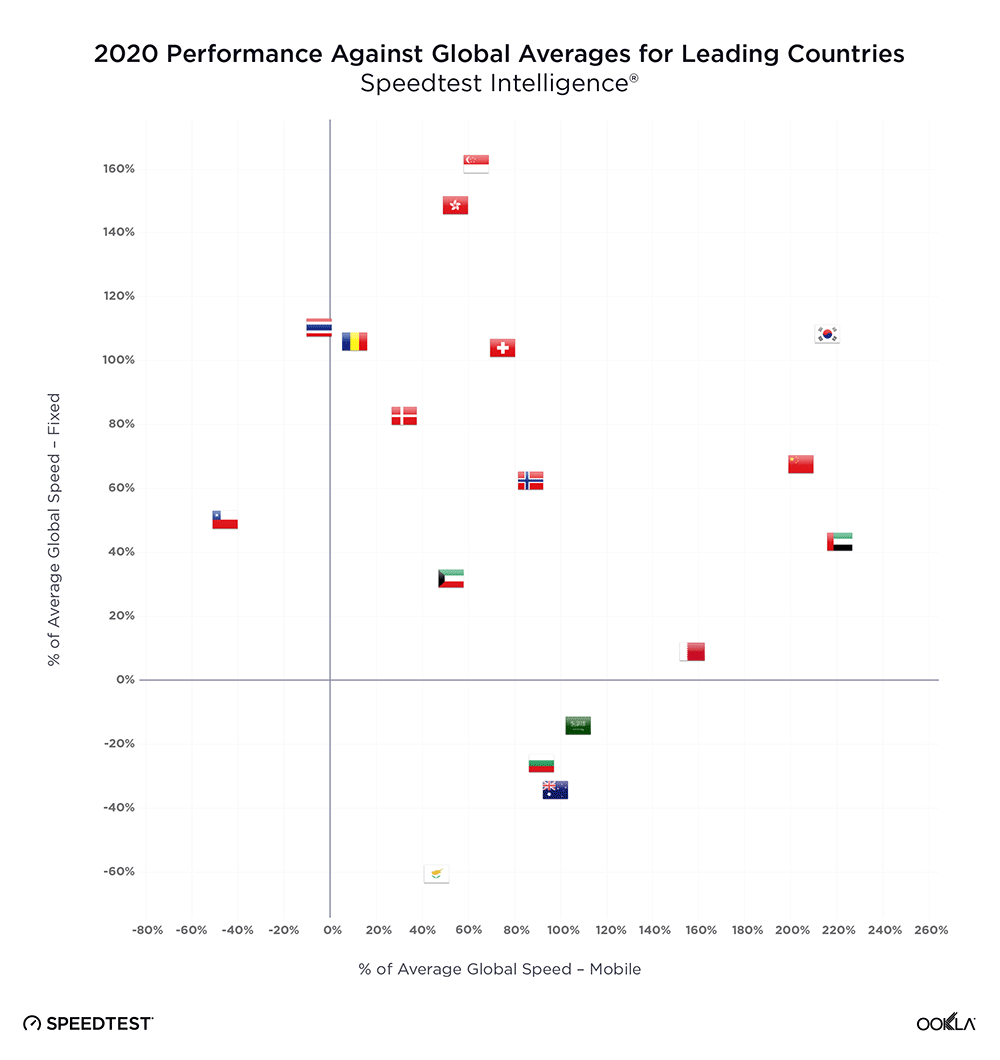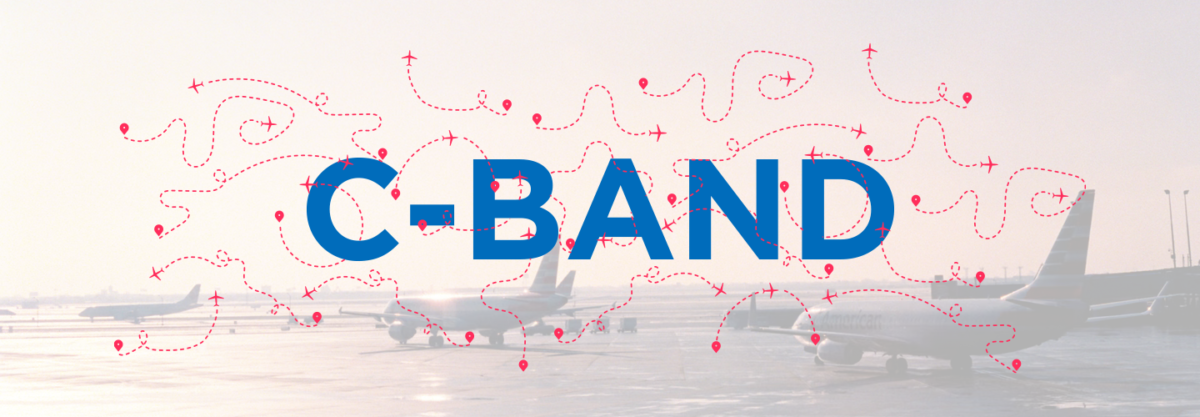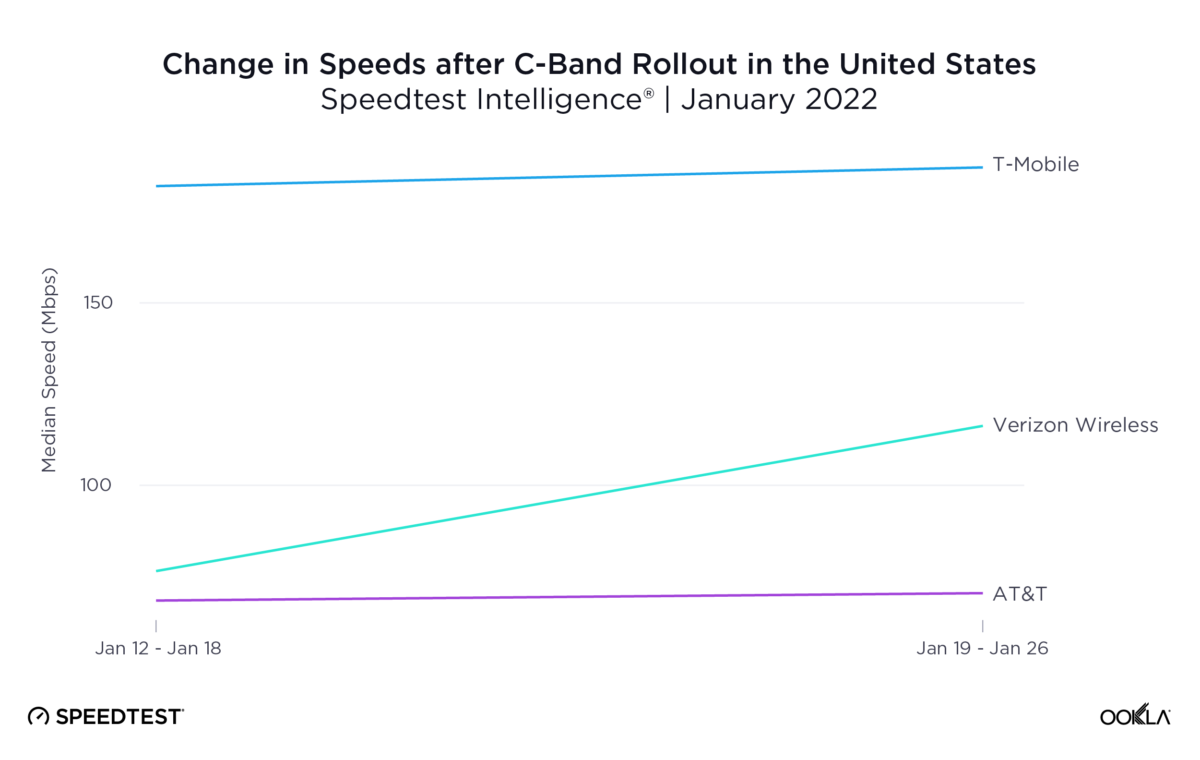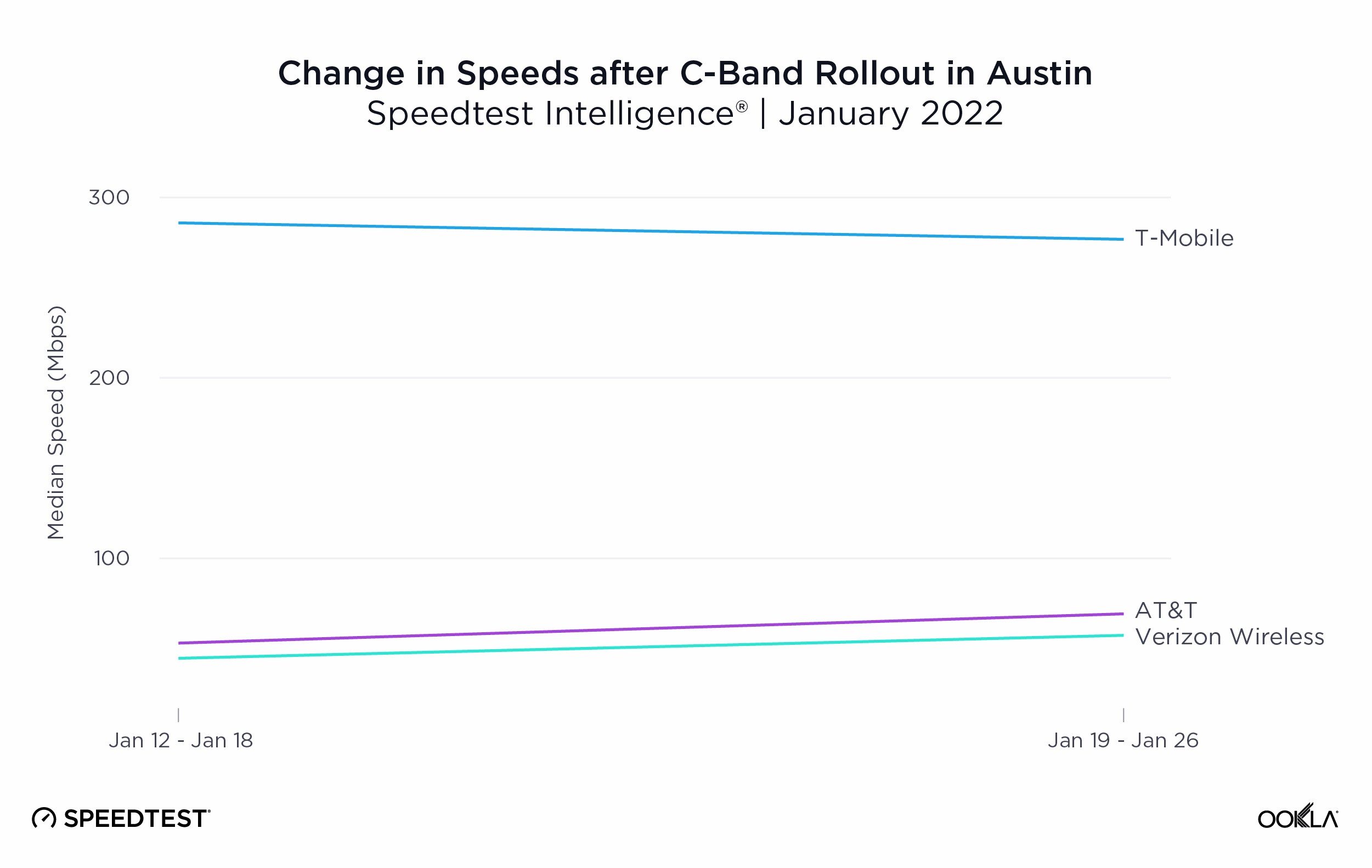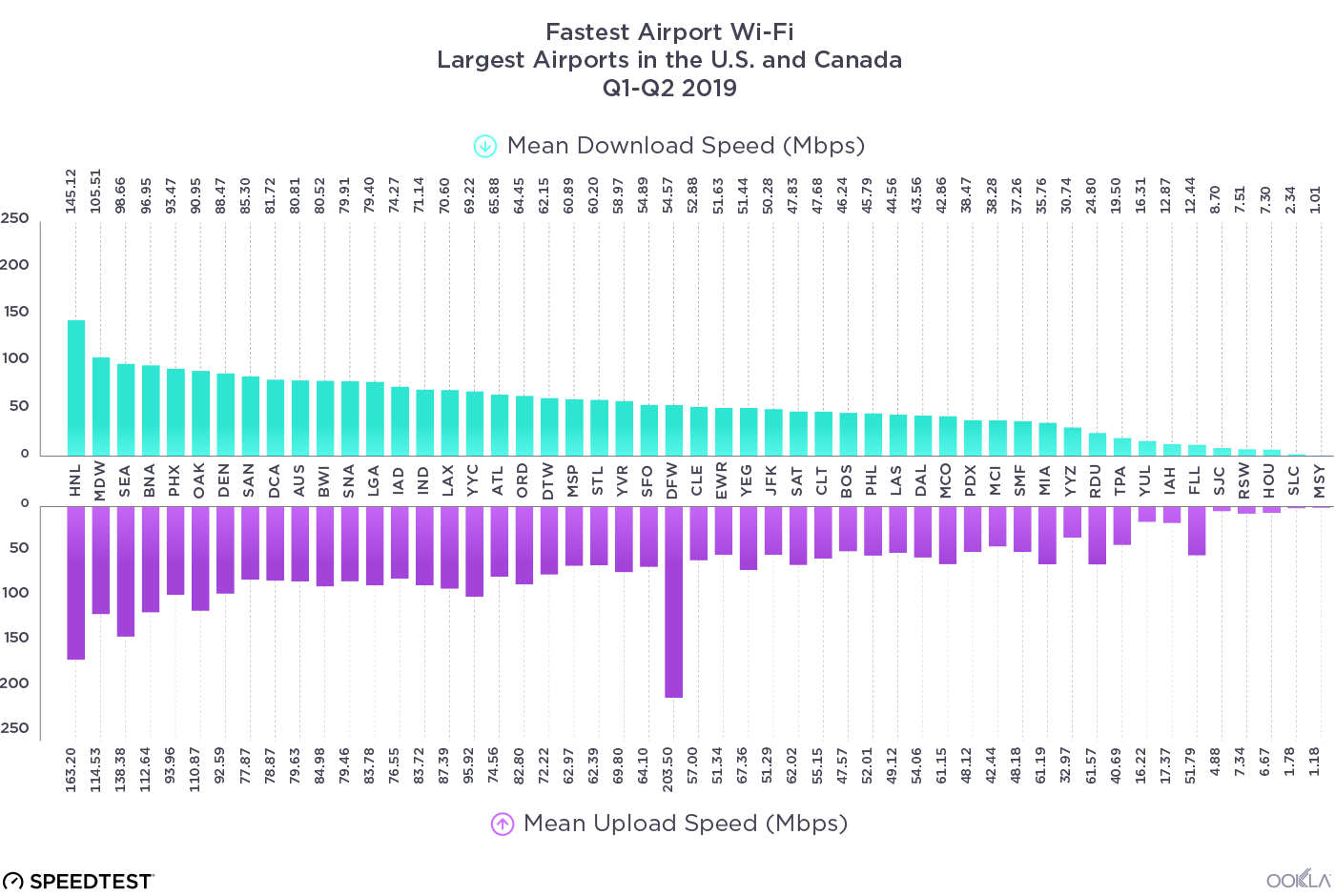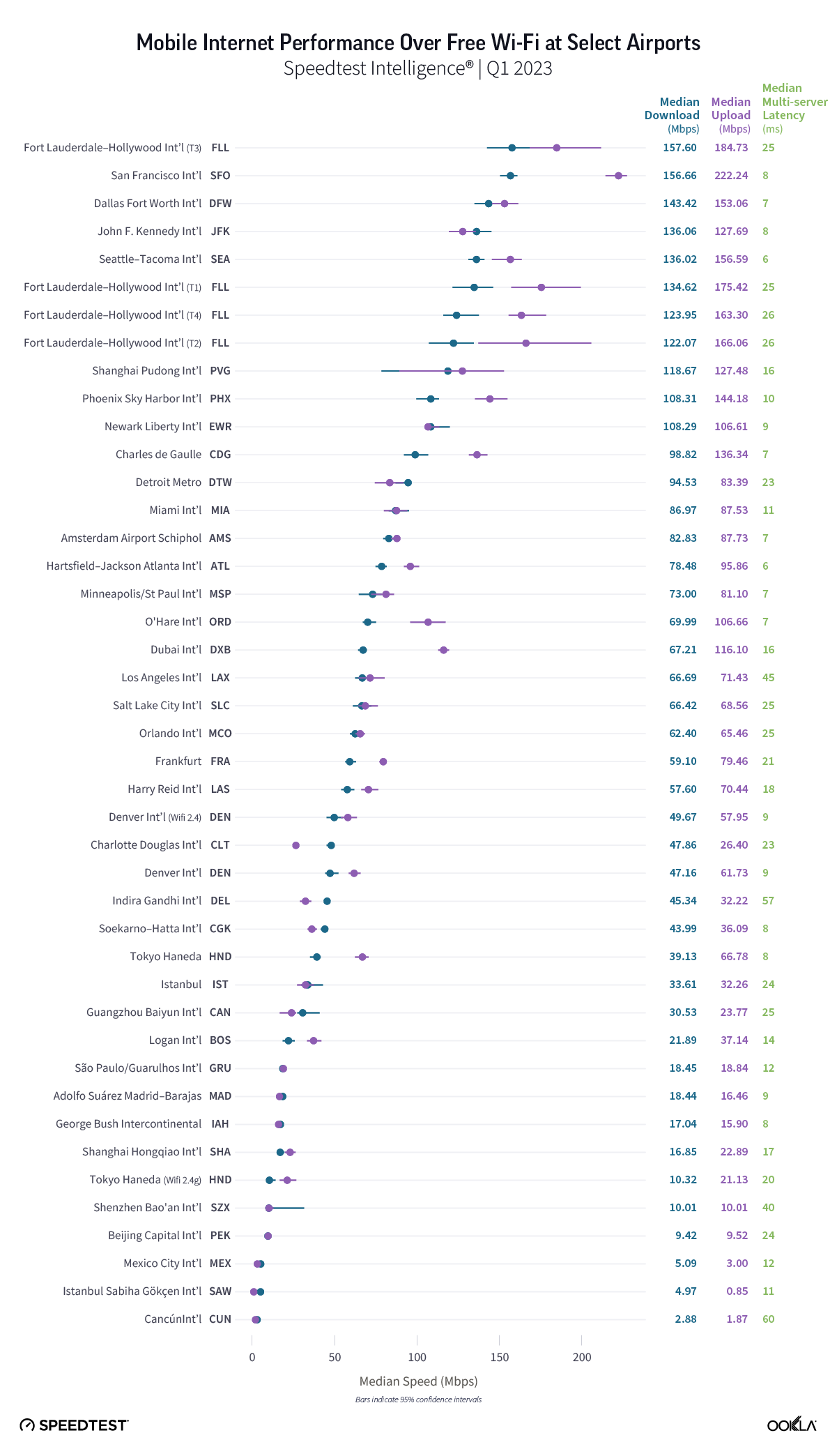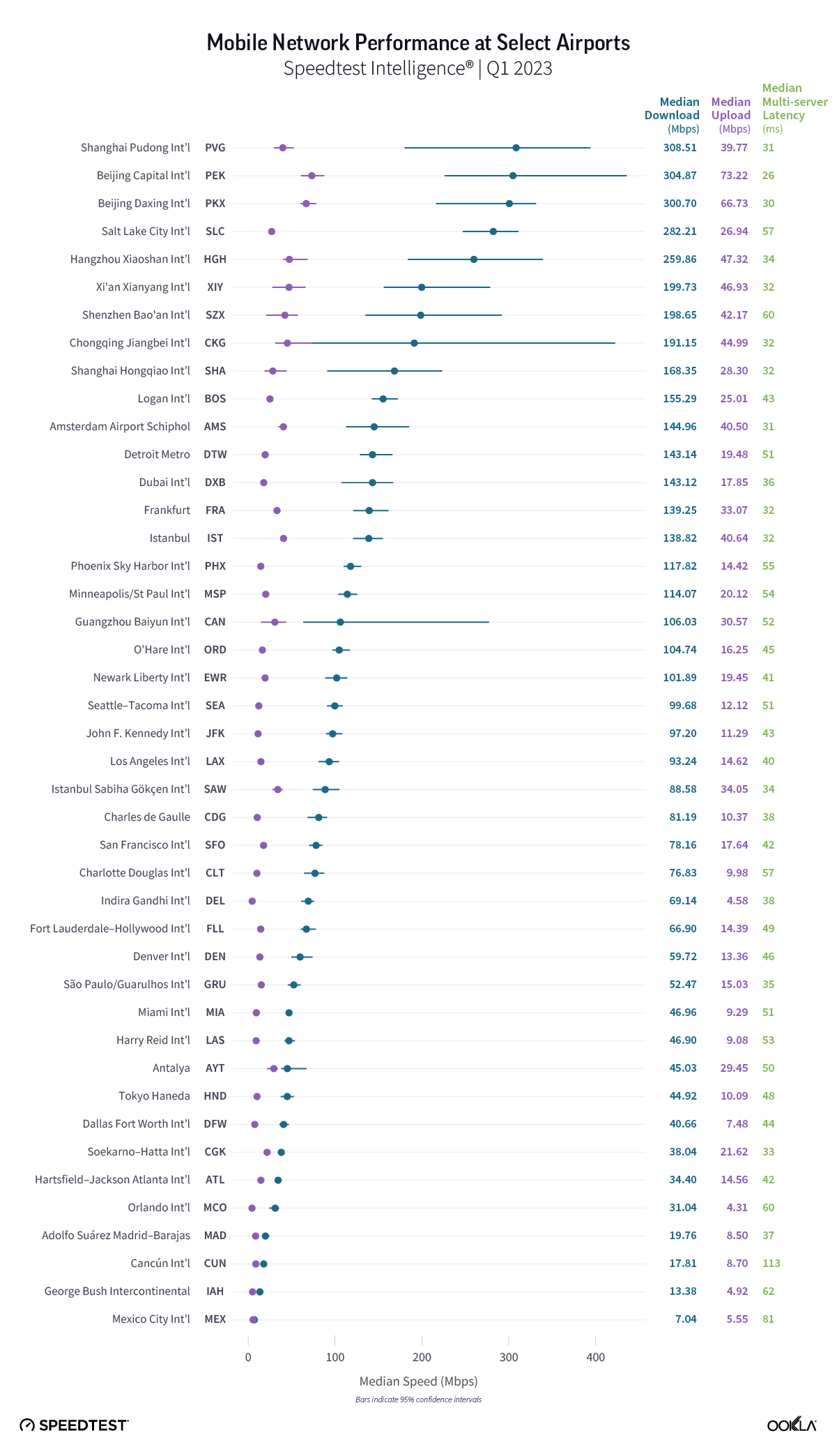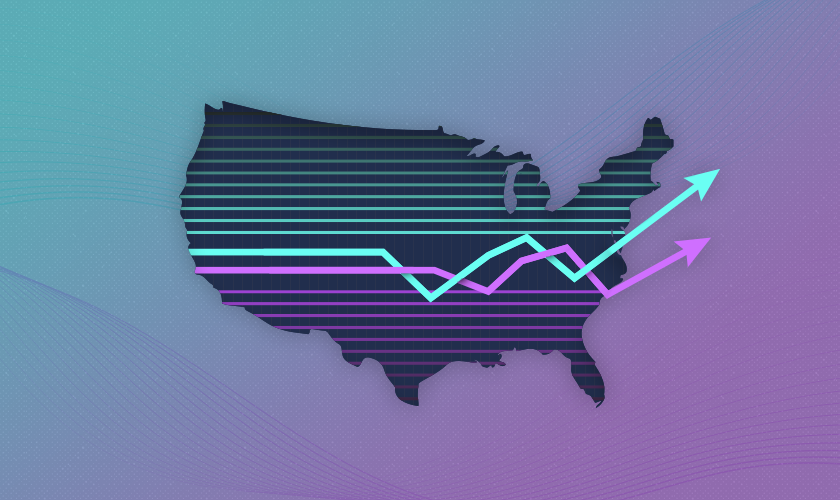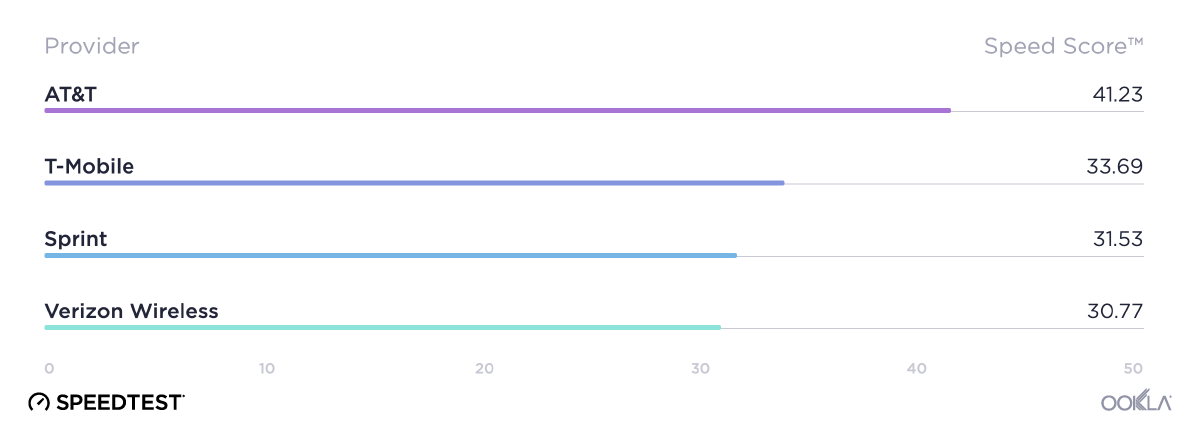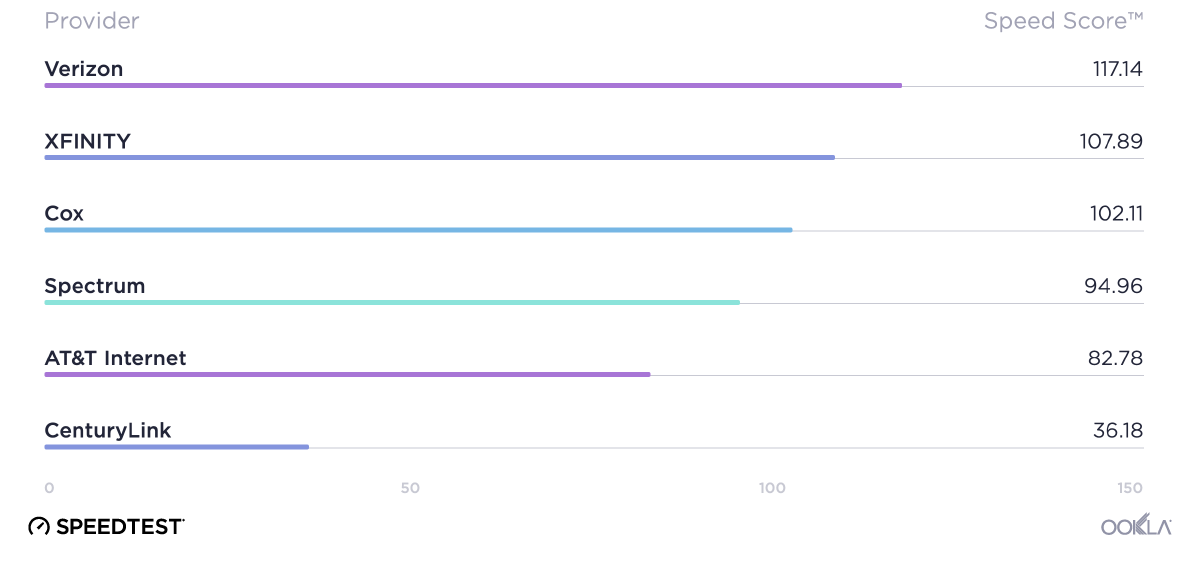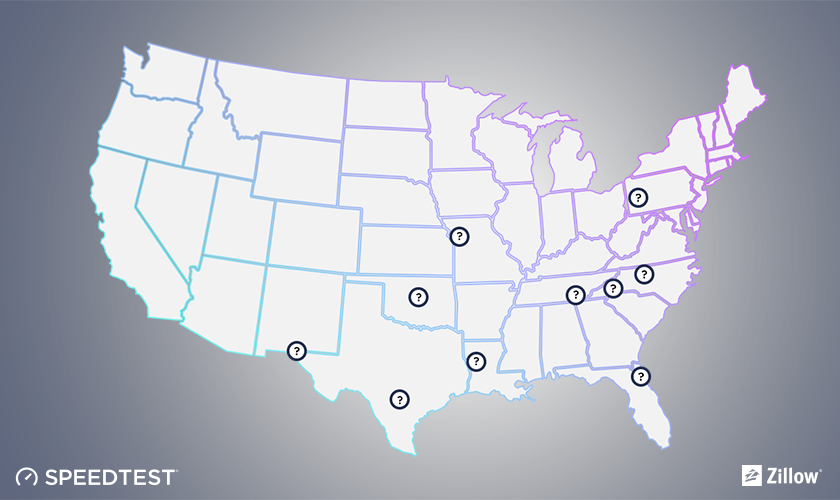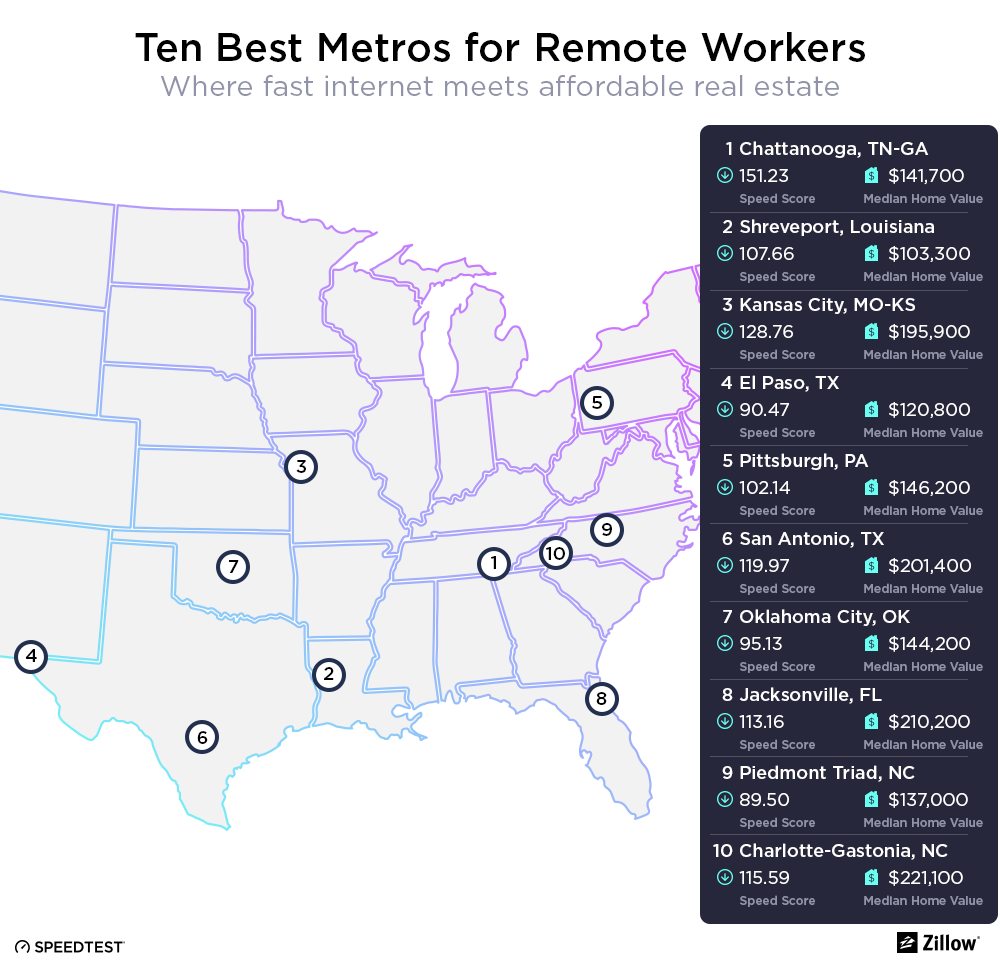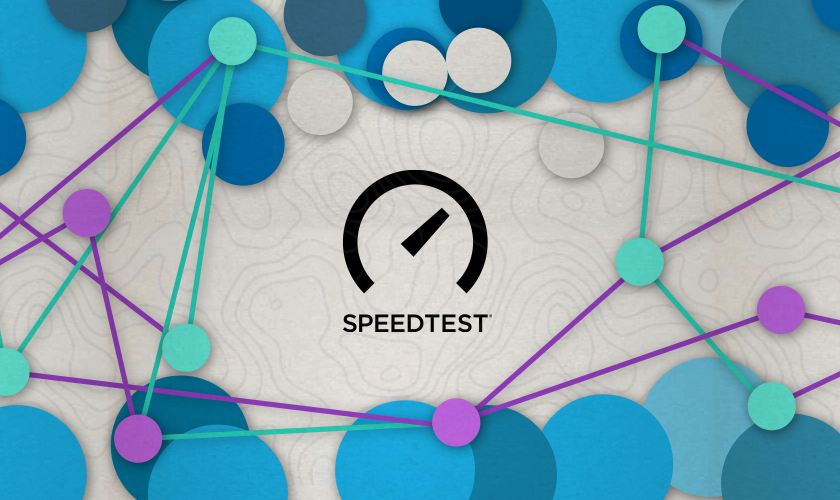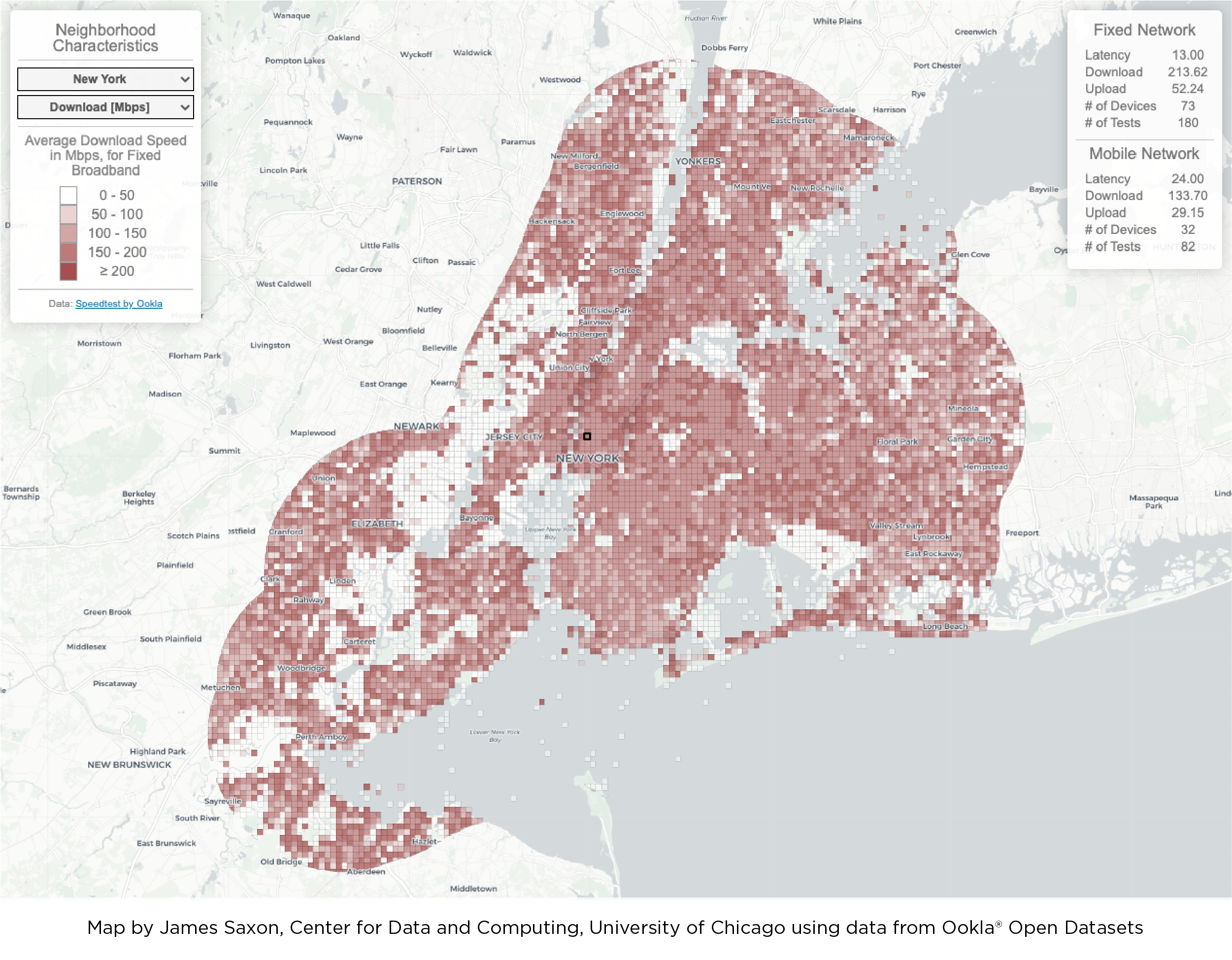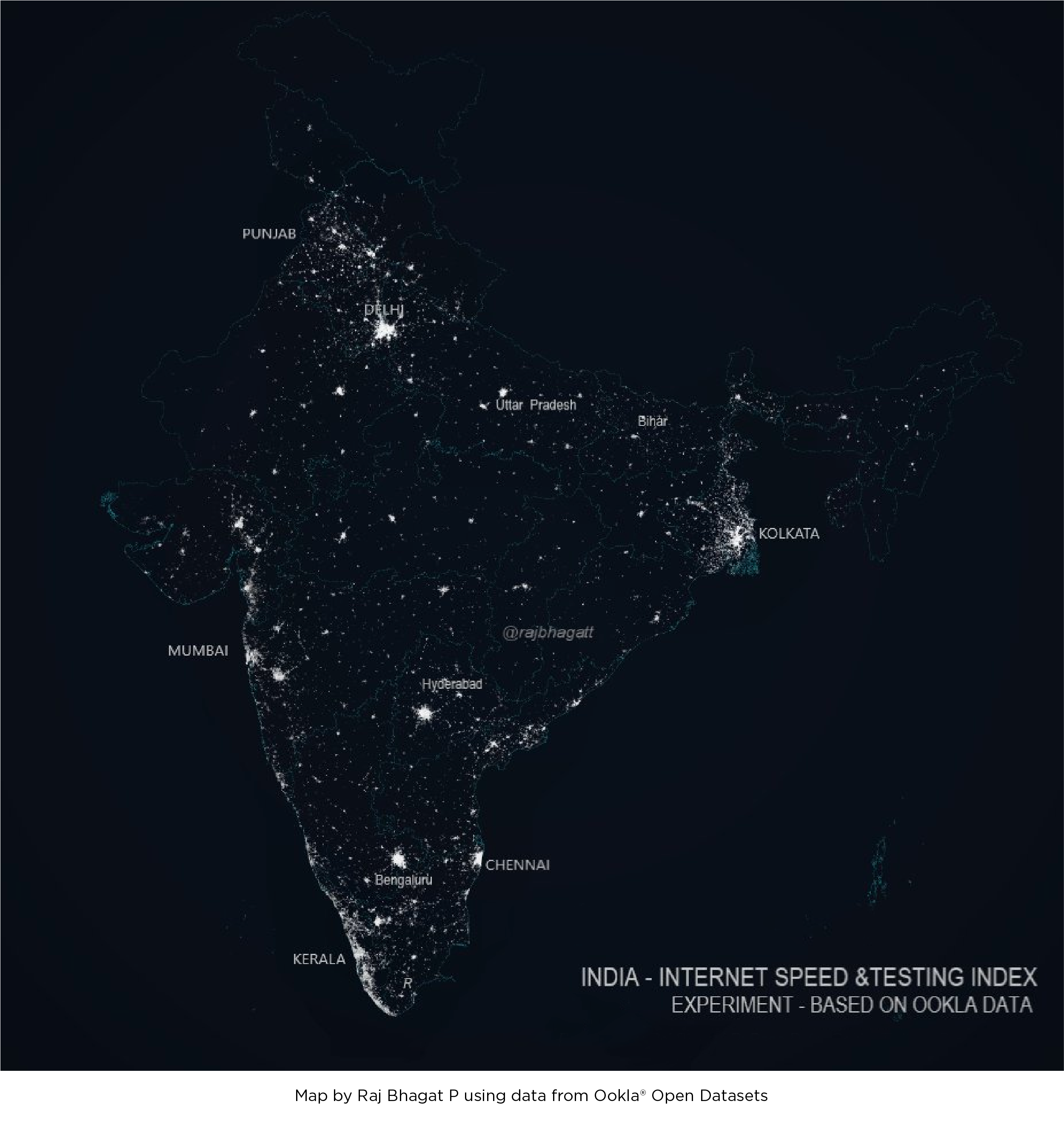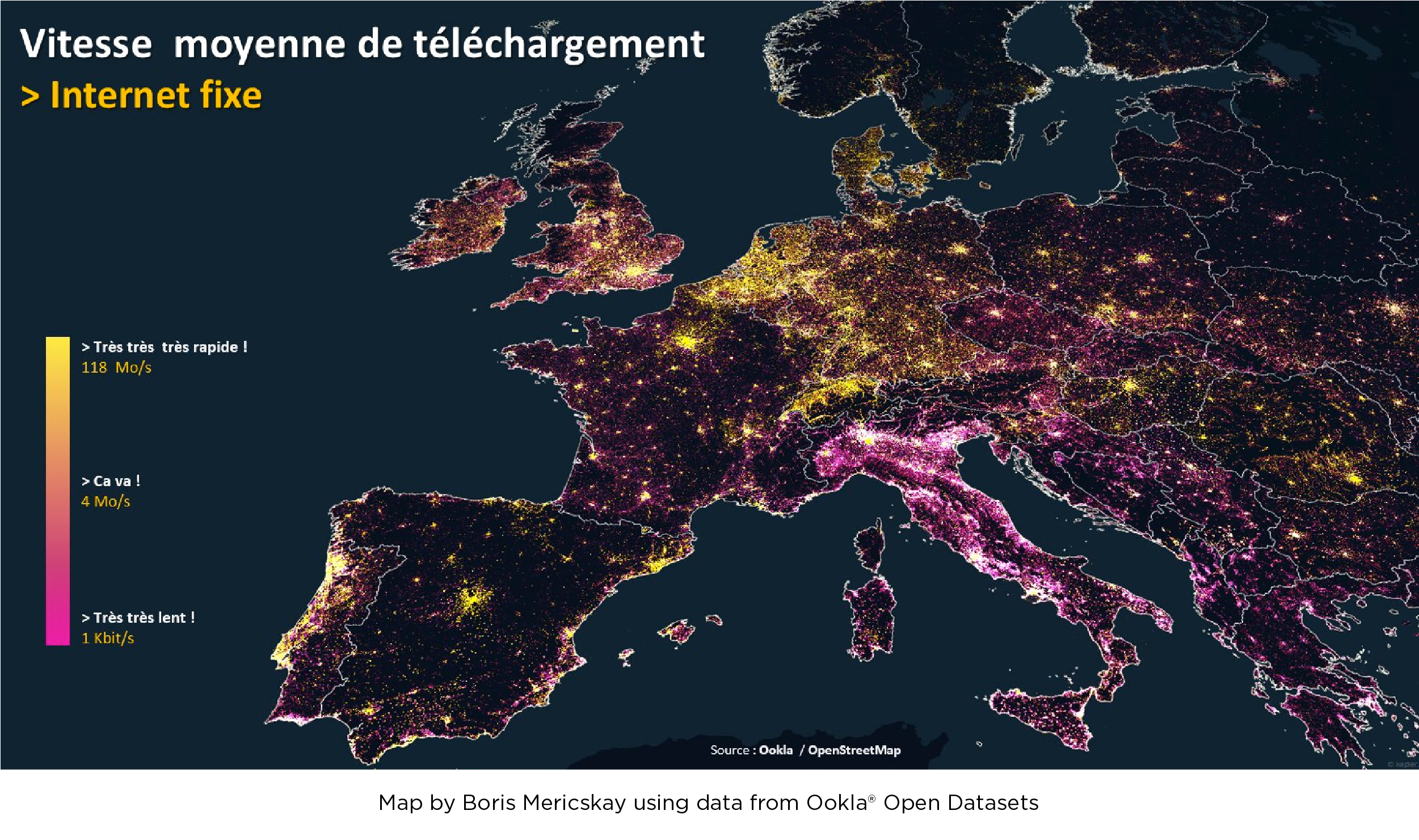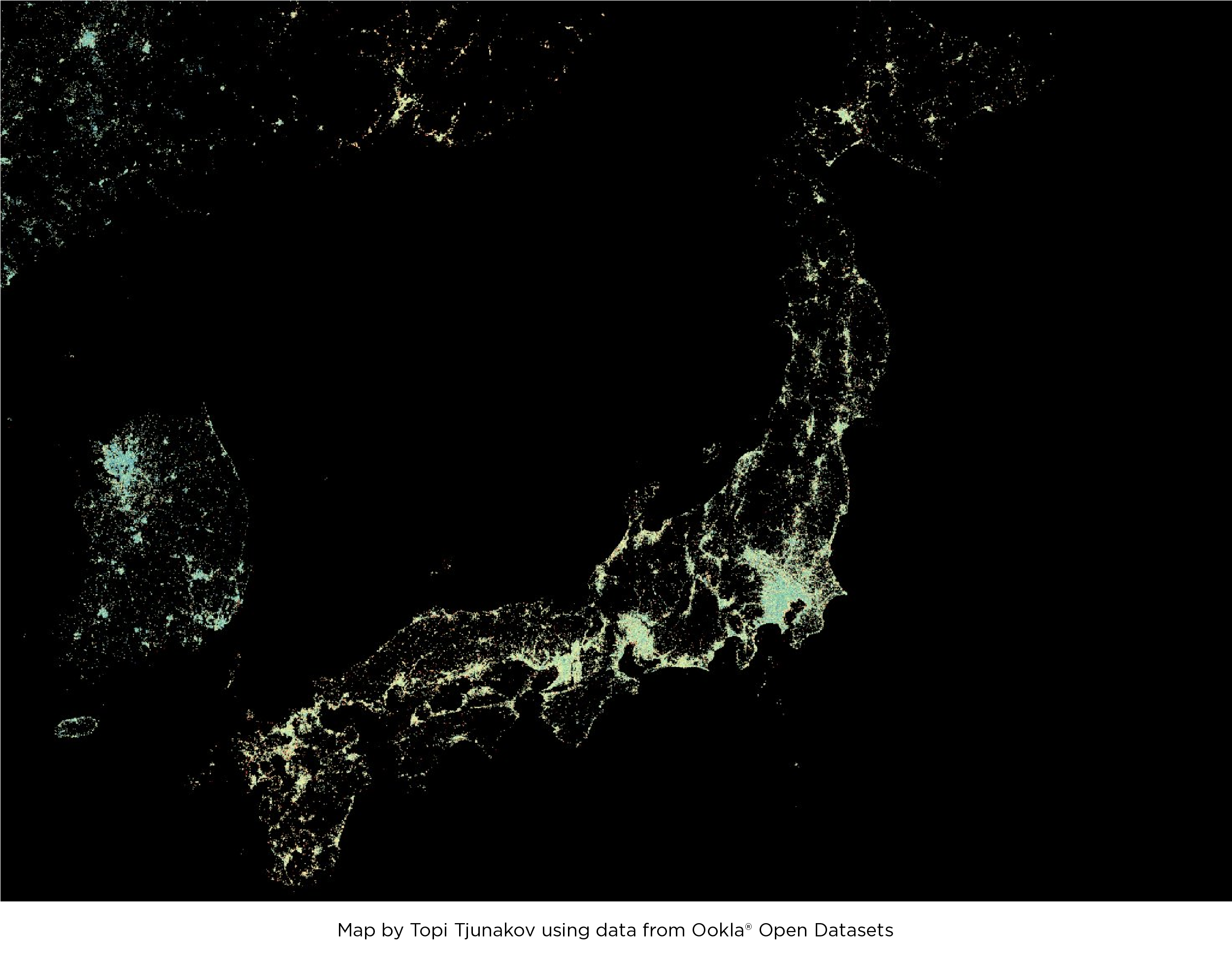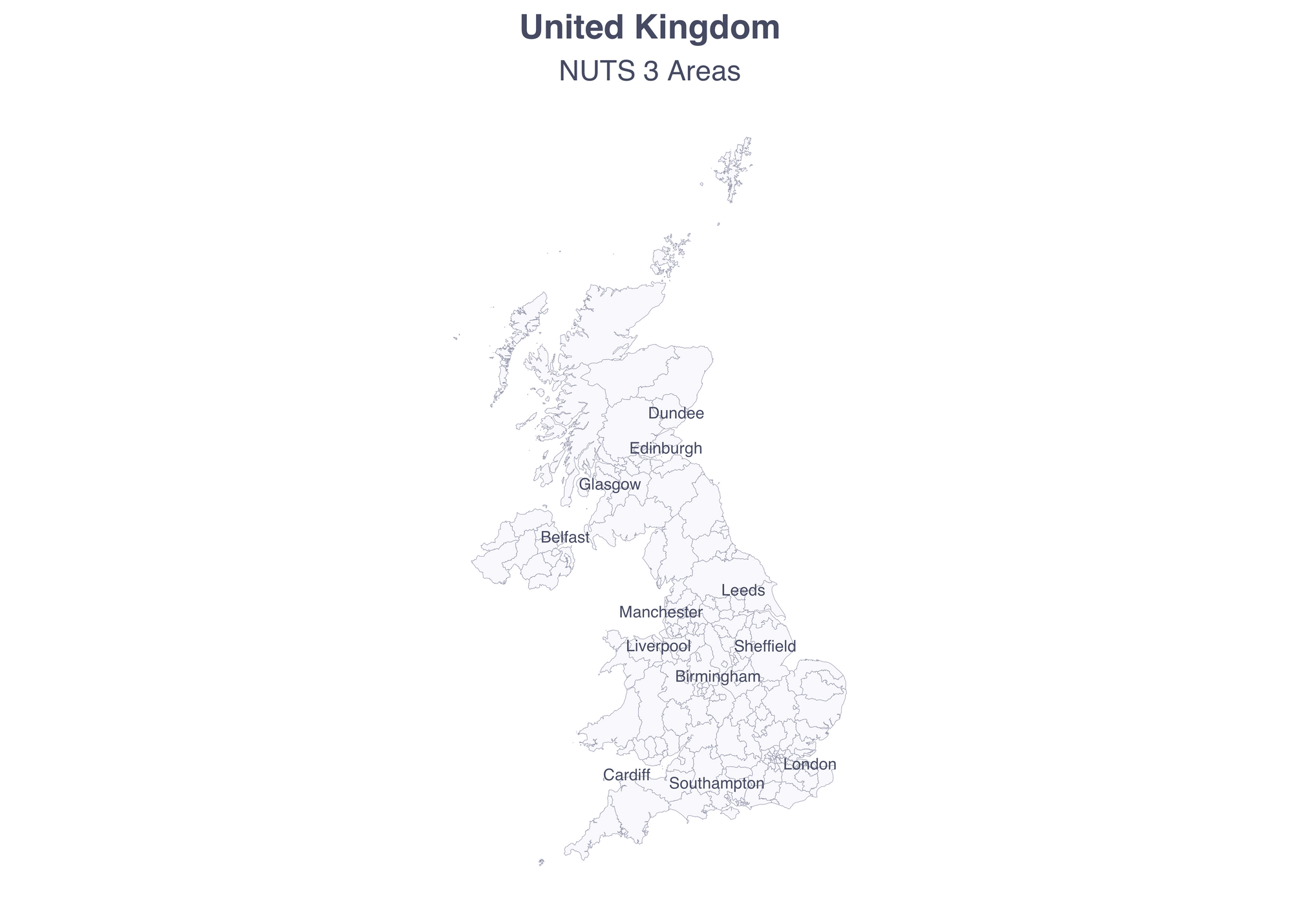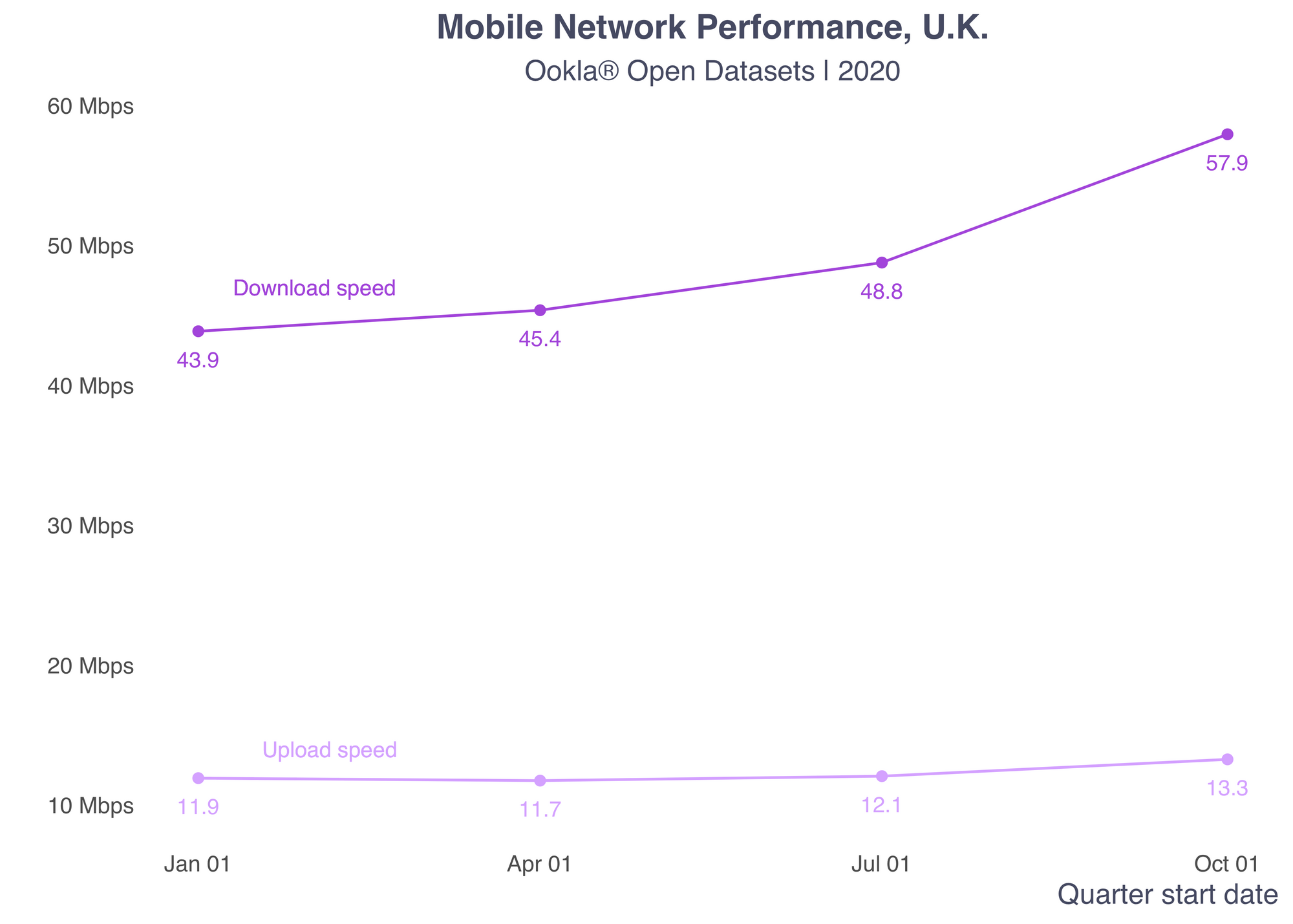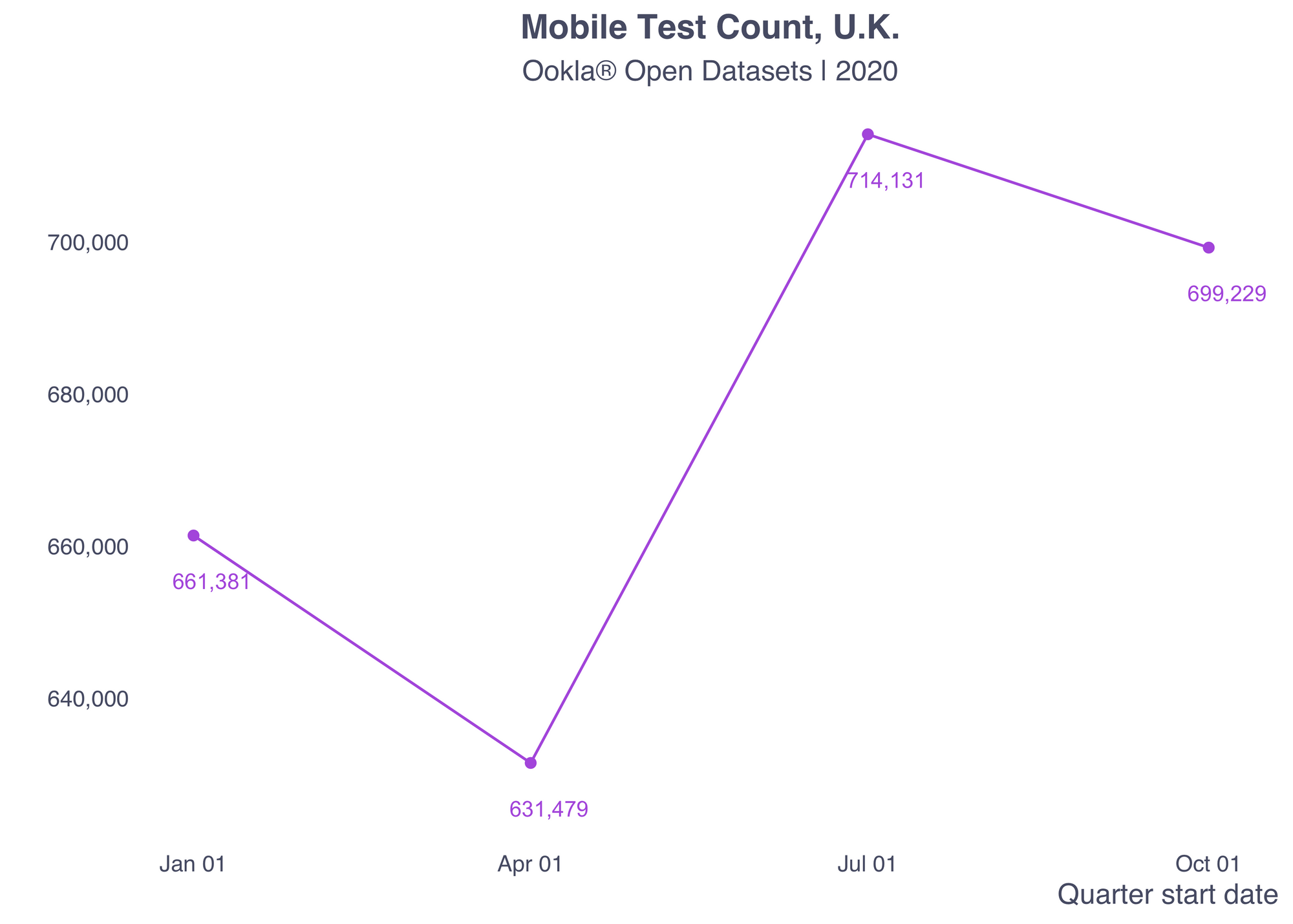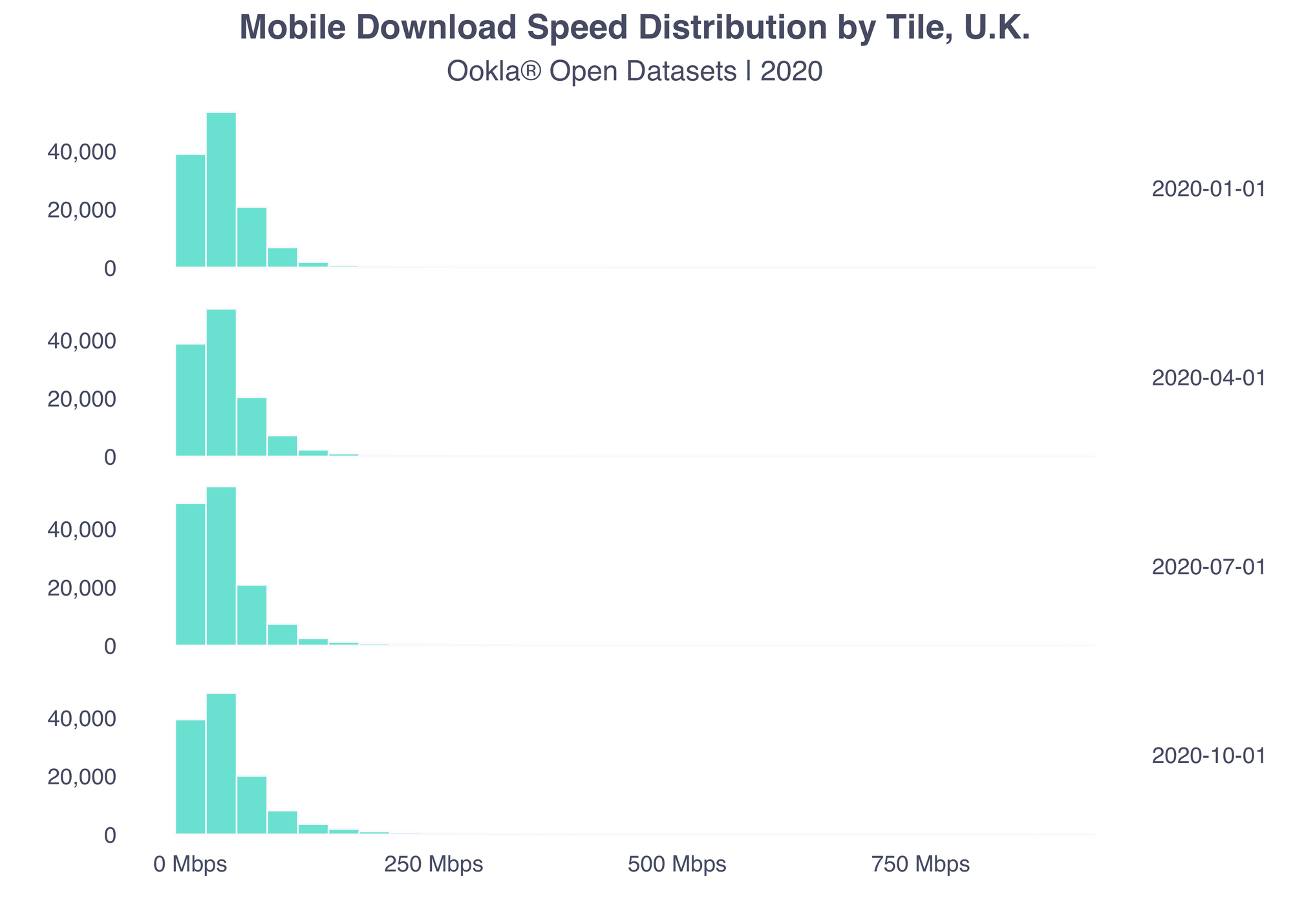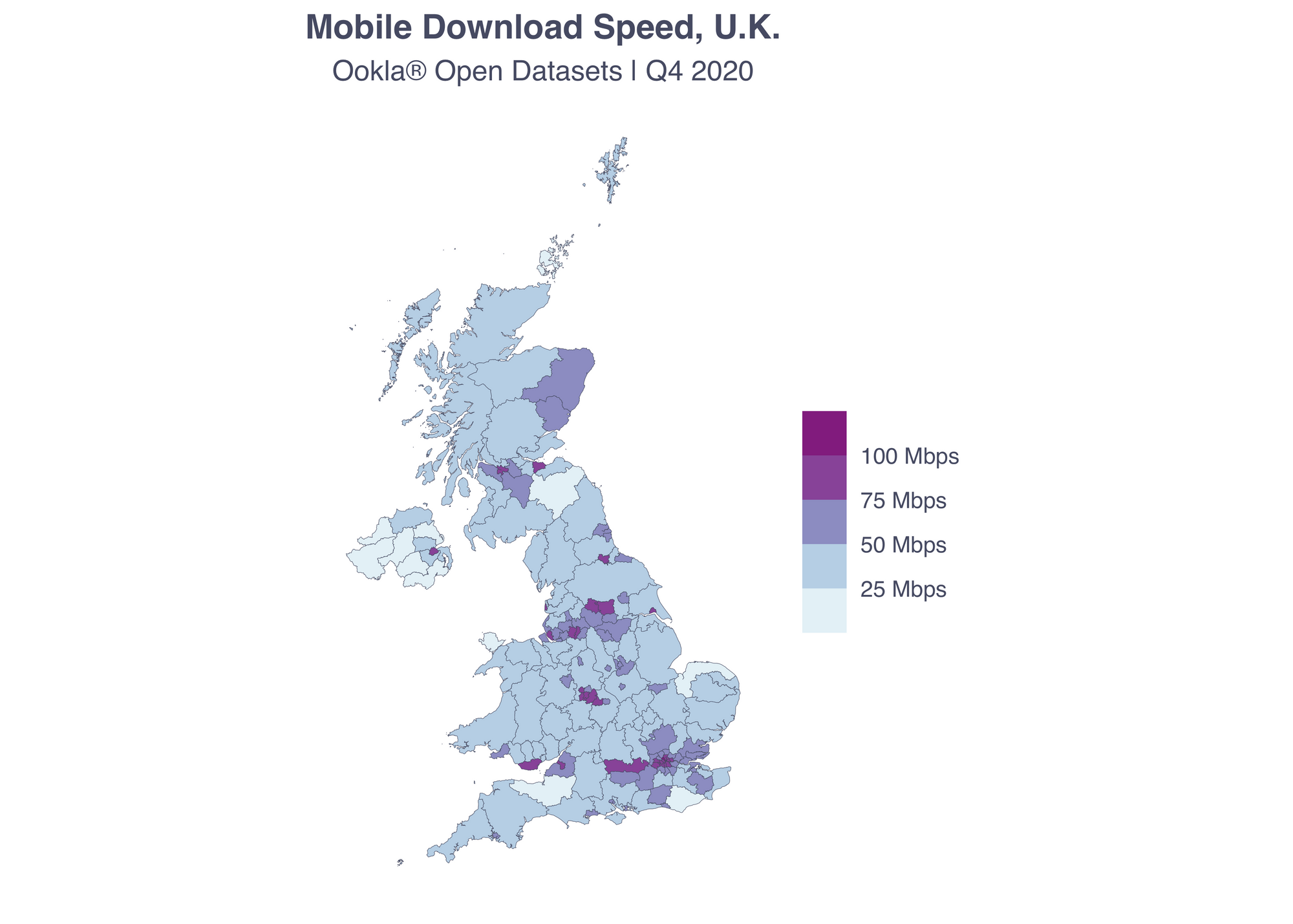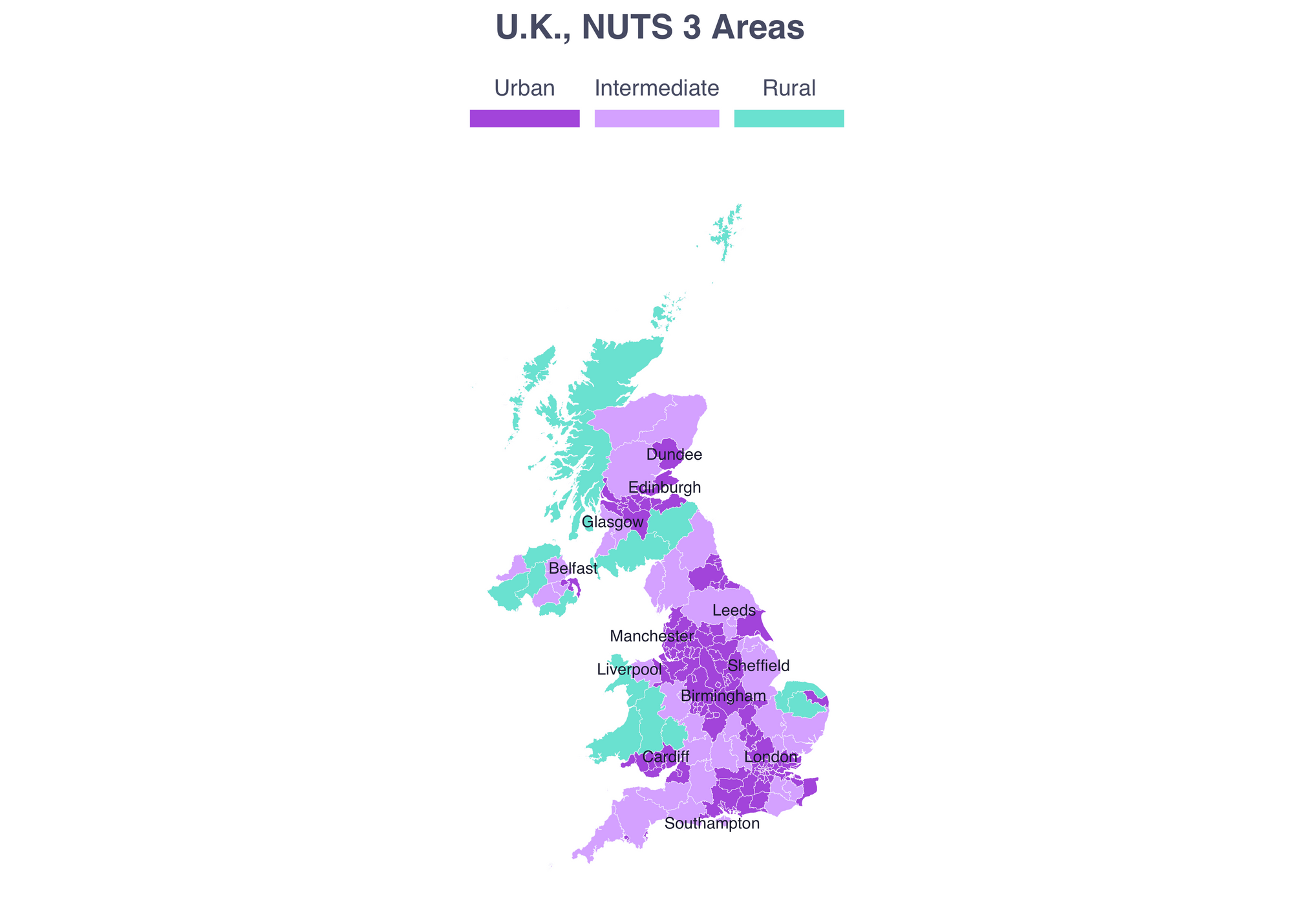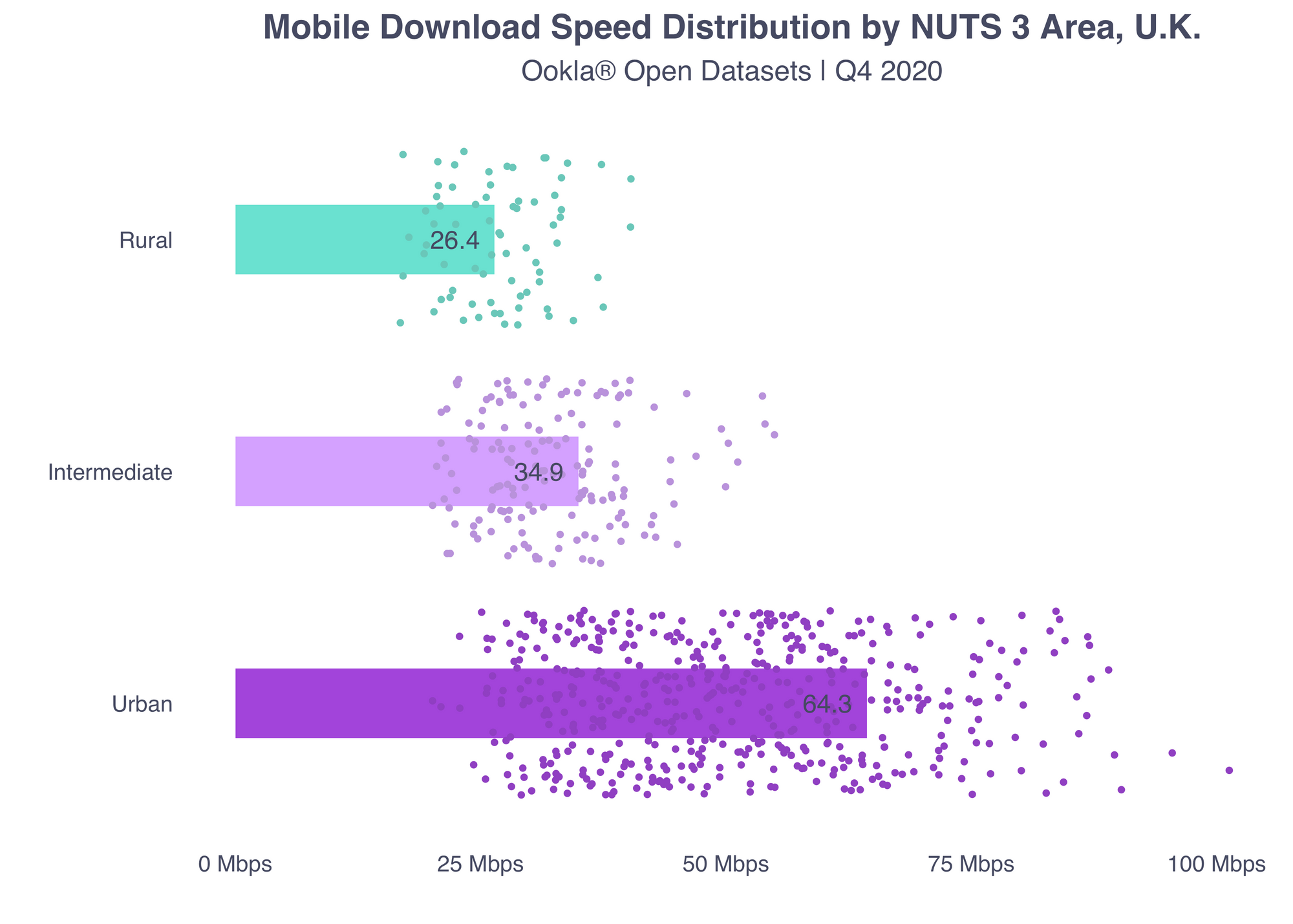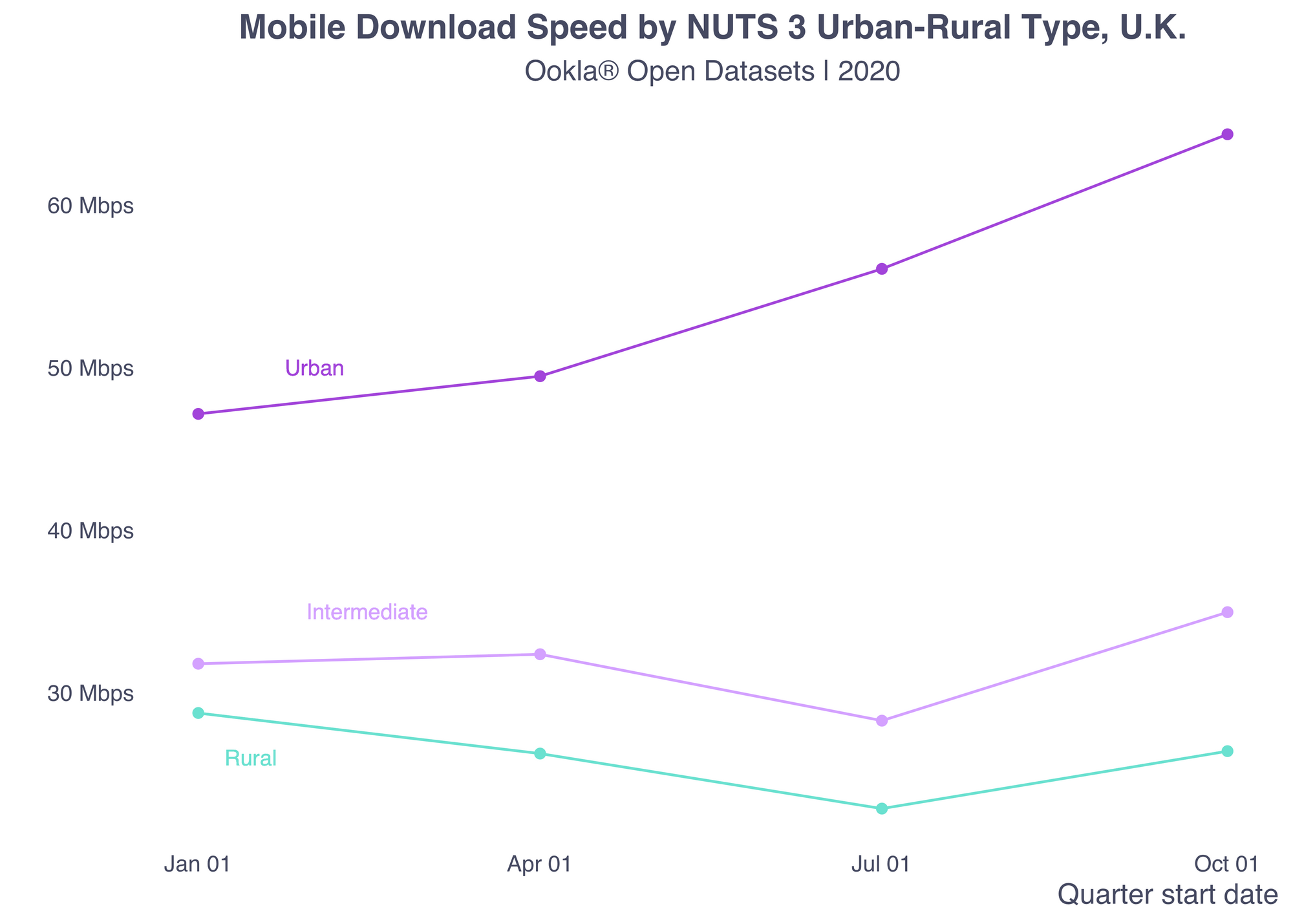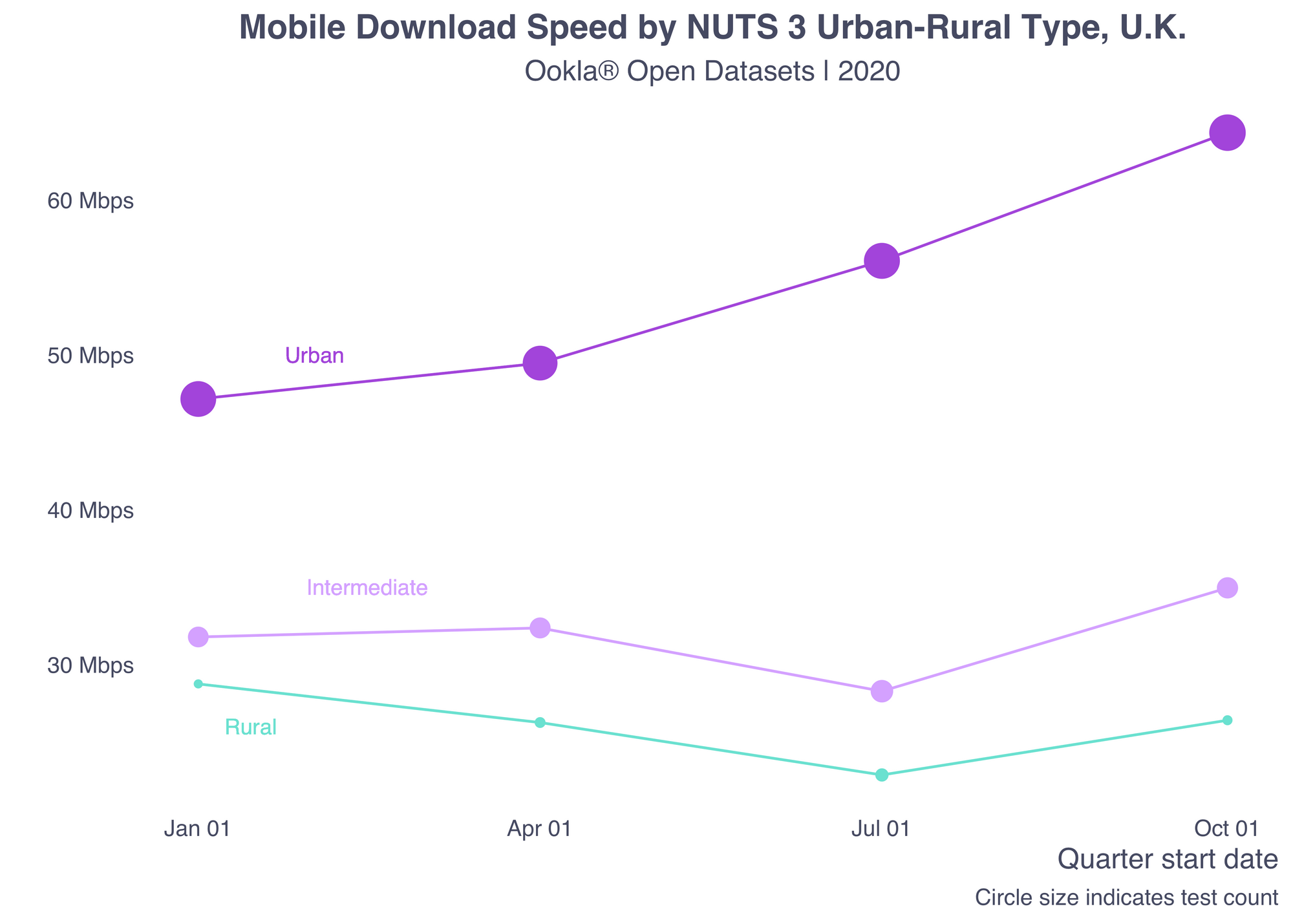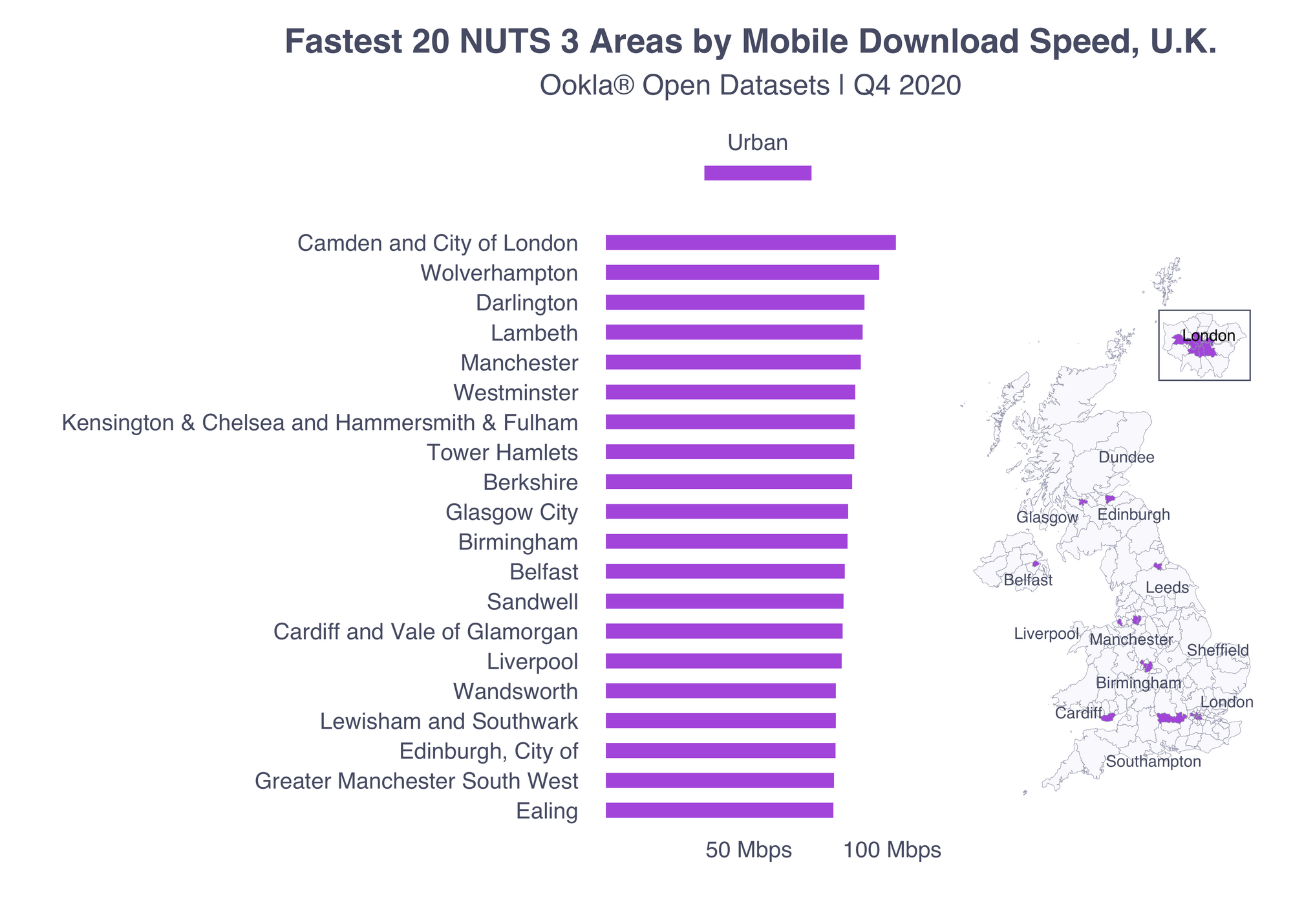Ookla® Market Reports™ identify key data about internet performance in countries across the world. This quarter we’ve provided updated analyses for 51 markets using Speedtest Intelligence® and summarized a few top takeaways below. Click through to the market report to see more details and charts about the countries you’re interested in, including the fastest fixed broadband providers and mobile operators, who had the most consistent service, and 5G and device performance in select countries during Q3 2023. Jump forward to a continent using these links:
Africa | Americas | Asia | Europe | Oceania
Africa
- Côte d’Ivoire: Orange recorded the fastest median mobile and fixed download speeds during Q3 2023, at 24.33 Mbps and 66.84 Mbps, respectively. Moov Africa recorded the lowest median multi-server latency over fixed broadband at 122 ms. Of Côte d’Ivoire most populous cities, Bouake had the fastest median fixed download speed of 59.22 Mbps, just ahead of Abidjan with 58.44 Mbps.
- Mozambique: There were no statistical winners for fastest median mobile download speed during Q3 2023, with Vodacom and Tmcel delivering median download speeds of 31.16 Mbps and 27.89 Mbps, respectively. Tmcel recorded the lowest mobile multi-server latency at 52 ms and the highest Consistency at 91.8%. Of Mozambique’s most populous cities, Maputo had the fastest median mobile and fixed download speeds at 28.71 Mbps and 12.57 Mbps, respectively. SpaceX’s Starlink recorded the fastest fixed broadband median download speed in Q3 2023 at 53.98 Mbps, along with the highest Consistency at 60.3%. Meanwhile, TVCABO recorded the lowest median multi-server latency over fixed broadband at 14 ms.
- Senegal: There was no winner of fastest median mobile performance in Senegal during Q3 2023, with Orange and Free both tied. Orange led the market for median fixed broadband download performance, with 21.68 Mbps in Q3 2023. It also had the lowest median multi-server latency at 85 ms and highest Consistency of 45.3%. Of Senegal’s most populous cities, Dakar had the fastest median fixed download speed of 26.08 Mbps.
Americas
- Argentina: Personal had the fastest median download speed over mobile at 36.63 Mbps, while also registering lowest mobile multi-server latency at 39 ms during Q3 2023. In the fixed broadband market, there was no statistically fastest network, with Movistar and Telecentro delivering median download speeds of 102.55 Mbps and 101.96 Mbps, respectively. Movistar recorded the lowest multi-server latency of 10 ms. Among Argentina’s most populous cities, La Plata recorded the fastest mobile download speed of 35.48 Mbps, while Buenos Aires recorded the fastest fixed download speed of 105.50 Mbps.
- Belize: Digi had the fastest median mobile download and upload speeds of 17.23 Mbps and 10.38 Mbps, respectively during Q3 2023. Digi also recorded the highest Consistency of 81.5%, while smart! recorded the lowest median mobile multi-server latency of 55 ms. NEXGEN had the fastest median download and upload speeds over fixed broadband in Belize at 48.27 Mbps and 47.29 Mbps, respectively.
- Canada: Bell was the fastest mobile operator in Canada with a median download speed of 100.77 Mbps in Q3 2023. Bell also had the fastest median 5G download speed at 183.06 Mbps. Rogers had the fastest median mobile upload speed of 11.44 Mbps, and the highest Consistency of 82.9%. Bell pure fibre was fastest for fixed broadband, recording a median download speed of 286.08 Mbps and a median upload speed of 244.64 Mbps. Of Canada’s most populous cities, St. John’s recorded the fastest median mobile download speed at 158.19 Mbps, while Fredericton recorded the fastest median fixed broadband download speed of 238.49 Mbps.
- Colombia: Movistar was fastest for fixed broadband with a median download speed of 181.42 Mbps in Q3 2023. ETB had the lowest median multi-server latency over fixed broadband at 9 ms. Of Colombia’s most populous cities, Cartagena recorded the fastest median fixed download speed of 125.15 Mbps.
- Costa Rica: Claro had the fastest median download and upload speeds among mobile operators at 52.38 Mbps and 12.56 Mbps, respectively. Liberty had the lowest mobile multi-server latency at 33 ms and the highest Consistency at 80.1%. Metrocom was fastest for fixed broadband download and upload performance, at 213.77 Mbps and 157.89 Mbps, respectively.
- Dominican Republic: Claro had the fastest median download and upload speeds among mobile operators at 32.22 Mbps and 9.27 Mbps, respectively. Viva had the lowest mobile multi-server latency at 44 ms. SpaceX’s Starlink was fastest for fixed broadband download performance at 49.21 Mbps, while Claro recorded the fastest median upload speed at 14.81 Mbps, as well as the lowest multi-server latency at 40 ms. Of the Dominican Republic’s most populous cities, Santo Domingo recorded the fastest median mobile and fixed download speeds of 37.43 Mbps and 44.92 Mbps, respectively.
- Ecuador: There was no winner of fastest median mobile performance in Ecuador during Q3 2023, with CNT and Claro posting median download speeds of 28.00 Mbps and 26.65 Mbps, respectively. Movistar recorded the lowest mobile multi-server latency, of 40 ms. Netlife was fastest for fixed broadband, with a median download speed of 90.31 Mbps. Netlife also recorded the lowest multi-server latency over fixed broadband at 8ms.
- El Salvador: Claro had the fastest median download speed among mobile operators at 41.26 Mbps, along with the highest Consistency of 88.5%. Movistar registered the lowest median multi-server latency in El Salvador at 59 ms. Cable Color recorded the fastest median fixed download speed at 54.91 Mbps, the top median upload speed at 49.87 Mbps, and the lowest median multi-server latency of 42 ms.
- Guatemala: Claro was the fastest mobile operator in Guatemala with a median download speed of 37.39 Mbps and a median upload speed of 20.43 Mbps. Claro also had the highest Consistency at 86.1%, while also leading the market for 5G performance, with a median 5G download speed of 370.97 Mbps. SpaceX’s Starlink was fastest for median fixed download performance at 56.91 Mbps, while Cable Color was fastest for fixed upload performance at 28.96 Mbps. Cable Color also had the lowest median multi-server latency on fixed broadband at 34 ms.
- Guyana: There was no winner of fastest median mobile performance in Guyana during Q3 2023, with ENet and Digicel posting median download speeds of 32.48 Mbps and 28.01 Mbps, respectively. ENet recorded the fastest median mobile upload speed at 18.03 Mbps and offered the lowest median multi-server latency at 137 ms. In the fixed broadband market, ENet recorded the fastest median download and upload speeds, of 61.46 Mbps and 39.75 Mbps, respectively.
- Haiti: Digicel was the fastest mobile operator in Haiti with a median mobile download speed of 13.77 Mbps, a median upload speed of 9.92 Mbps, and Consistency of 67.4%. SpaceX Starlink had the fastest median fixed download speed at 50.18 Mbps. Natcom had the fastest median fixed upload speed at 32.10 Mbps and the lowest median fixed multi-server latency at 41 ms.
- Honduras: Claro had the fastest median download and upload speeds over mobile at 54.06 Mbps and 15.75 Mbps, respectively. Claro also had the lowest mobile median multi-server latency at 89 ms and highest Consistency at 88.4%. Claro recorded the fastest median fixed broadband download speed of 46.11 Mbps, while TEVISAT had the fastest median upload speed of 21.30 Mbps and lowest median multi-server latency of 32 ms.
- Jamaica: There was no winner of fastest median mobile download performance in Jamaica during Q3 2023, with Digicel and Flow tied. Digicel recorded the fastest median upload speed of 9.55 Mbps and highest Consistency of 85.8%. Flow had the lowest mobile median multi-server latency at 36 ms. SpaceX Starlink had the fastest median download speed over fixed broadband at 79.85 Mbps.
- Mexico: Telcel had the fastest median download speed over mobile at 50.81 Mbps, and the operator also delivered the fastest median 5G download speed at 223.06 Mbps. Telcel also had the lowest mobile median multi-server latency at 63 ms and highest Consistency at 87.1%. Totalplay was fastest for fixed broadband with a median download speed of 88.28 Mbps and upload speed of 30.60 Mbps. Totalplay also had the lowest median multi-server latency at 27 ms. Among Mexico’s most populous cities, Monterrey recorded the fastest median download speeds on both mobile and fixed, at 39.47 Mbps and 77.94 Mbps, respectively.
- Panama: MasMovil was the fastest mobile operator with median download and upload speeds of 23.66 Mbps and 15.49 Mbps, respectively, as well as the highest Consistency of 80.6%. MasMovil was also the fastest fixed network provider, with a median download speed of 147.50 Mbps and a median upload speed of 30.12 Mbps.
- Peru: Claro was the fastest mobile operator with a median download speed of 22.27 Mbps,and Claro also had the highest mobile Consistency in the market with 80.3%.
- Trinidad and Tobago: Digicel had the fastest median download speed over mobile at 34.92 Mbps and highest Consistency of 89.4%. Digicel+ had the fastest median fixed broadband download and upload speeds at 114.20 Mbps and 105.21 Mbps, respectively. Digicel+ also had the lowest median multi-server latency at 7 ms, as well as the highest Video Score at 82.35.
- United States: T-Mobile was the fastest mobile operator with a median download speed of 163.59 Mbps. T-Mobile also had the fastest median 5G download speed at 221.57 Mbps, as well as the lowest 5G multi-server latency of 50 ms. Cox led the market as the fastest fixed broadband provider with a median download speed of 260.09 Mbps, while AT&T Internet recorded the fastest median fixed upload speed of 188.60 Mbps, and Verizon had the lowest median multi-server latency on fixed broadband at 16 ms.
- Uruguay: Antel was the fastest mobile operator with a median download speed of 182.79 Mbps, and Antel also had the lowest median multi-server latency of 42 ms.
- Venezuela: Digitel was the fastest mobile operator with a median download speed of 13.53 Mbps and a median upload speed of 6.54 Mbps. Digitel also recorded the highest Consistency in the market, with 66.2%, and the lowest median multi-server latency of 95 ms. Airtek Solutions had the fastest fixed median download speed of 82.79 Mbps, upload speed of 88.09 Mbps, and the lowest median multi-server latency at 7 ms.
Asia
- Afghanistan: The fastest mobile operator in Afghanistan was Afghan Wireless with a median download speed of 6.38 Mbps. The operator also had the lowest median multi-server latency at 74 ms and the highest Consistency of 52.3% in Q3 2023.
- Bangladesh: Banglalink was the fastest mobile operator in Bangladesh with a median download speed of 25.03 Mbps in Q3 2023. Banglalink also recorded the highest Consistency of 85.3% and the lowest median multi-server latency of 35ms. DOT Internet was the fastest fixed broadband provider with a median download speed of 90.20 Mbps, while also recording the highest Consistency at 85.6% and the lowest median multi-server latency at 5 ms.
- Bhutan: There was no statistical winner for fastest mobile download performance during Q3 2023 in Bhutan, with BT and TashiCell both tied.
- Brunei: There was no statistical winner for fastest mobile download performance during Q3 2023 in Brunei, with DST and Imagine both tied.
- Cambodia: Cellcard recorded the fastest median mobile download speed at 31.76 Mbps during Q3 2023, while Metfone recorded the highest Consistency at 81.0% and the lowest median multi-server latency at 38 ms. There was no statistical winner among top providers in Cambodia for median fixed download speed, with SINET and MekongNet both tied.
- China: China Mobile was the fastest mobile operator with a median download speed of 179.81 Mbps, and highest Consistency of 95.6%. China Broadnet recorded the fastest median 5G download speed at 297.59 Mbps. China Unicom was fastest for fixed broadband at 208.59 Mbps. Among China’s most populous cities, Beijing recorded the fastest median mobile download speed of 220.21 Mbps, while Tianjin recorded the fastest median fixed download speed of 284.90 Mbps.
- Georgia: There was no statistical winner for fastest mobile download performance during Q3 2023 in Georgia, with Geocell and Magti both tied. Geocell recorded the lowest median mobile multi-server latency at 41 ms, while Magti recorded the highest mobile Consistency with 88.0%. MagtiCom had the fastest median fixed download speed at 27.80 Mbps during Q3 2023. It also recorded the highest Consistency, of 66.3%, and the lowest median multi-server latency at 12 ms. Among Georgia’s most populous cities, Gori recorded the fastest median mobile download speed of 39.01 Mbps, while Tbilisi recorded the fastest median fixed download speed of 26.98 Mbps.
- Indonesia: Telkomsel was the fastest Indonesian mobile operator with a median download speed of 31.04 Mbps. Telkomsel also had the lowest median mobile multi-server latency at 45 ms.
- Japan: Rakuten Mobile recorded the fastest mobile download and upload speeds during Q3 2023 in Japan, at 46.98 Mbps and 19.34 Mbps, respectively. The operator also recorded the highest Consistency in the market at 90.4%, while SoftBank recorded the lowest median multi-server latency at 44 ms. So-net had the fastest fixed download and upload speeds, at 270.59 Mbps and 213.43 Mbps, respectively, as well as the lowest median multi-server latency over fixed broadband at 9 ms.
- Malaysia: TIME was the fastest fixed broadband provider in Malaysia with a median download speed of 110.23 Mbps. TIME also recorded the highest Consistency in the market with 88.5% and the lowest multi-server latency at 9 ms.
- Pakistan: Jazz delivered the fastest median mobile download speed in Pakistan at 20.63 Mbps in Q3 2023 and the highest Consistency of 80.5%. Zong recorded the lowest median mobile multi-server latency of 52 ms. Transworld had the fastest median fixed broadband download speed in Pakistan at 18.91 Mbps and the highest Consistency at 40.1%.
- Philippines: Smart delivered the fastest median mobile download speed in the Philippines at 35.56 Mbps in Q3 2023.
- South Korea: SK Telecom recorded the fastest median mobile download and upload speeds at 174.80 Mbps and 17.94 Mbps, respectively, while also recording the highest Consistency in the market at 86.3%. LG U+ had the lowest median mobile multi-server latency in the market at 66 ms. In South Korea’s fixed broadband market, LG U+ delivered the fastest median download and upload speeds at 148.56 Mbps and 96.53 Mbps, respectively. LG U+ also recorded the lowest median multi-server latency of 38 ms.
- Sri Lanka: SLT-Mobitel delivered the fastest mobile and fixed download speed in Sri Lanka at 21.78 Mbps and 35.70 Mbps respectively in Q3 2023. Dialog had the lowest median mobile multi-server latency at 35 ms, while SLT-Mobitel recorded the lowest fixed broadband multi-server latency at 13 ms and the highest Consistency at 56.4%.
- Turkey: Turkcell was the fastest mobile operator in Turkey with a median download speed of 57.60 Mbps, and the operator also recorded the highest Consistency of 90.8%. Türk Telekom had the lowest median mobile multi-server latency at 41 ms. TurkNet was fastest for fixed broadband, with a median download speed of 64.31 Mbps. TurkNet also recorded the lowest median fixed multi-server latency at 13 ms, and highest Consistency at 80.6%. Among Turkey’s most populous cities, Istanbul recorded the fastest median download speeds across mobile and fixed, of 41.22 Mbps, and 44.38 Mbps, respectively.
- Vietnam: Vinaphone had the fastest median mobile download speed in Q3 2023, at 54.74 Mbps. Vinaphone also had the lowest median mobile multi-server latency at 34 ms and the highest Consistency at 94.7%. Viettel was the fastest fixed provider with a median download speed of 109.77 Mbps. Viettel also recorded the lowest median fixed broadband multi-server latency of 7 ms and the highest Consistency at 91.4%.
Europe
- Albania: There was no statistical winner for fastest mobile download performance during Q3 2023 in Albania, with One Albania and Vodafone tied. One Albania recorded the highest Consistency of 84.5%, while Vodafone recorded the lowest median multi-server latency at 35 ms. Digicom was the fastest fixed broadband provider with a median download speed of 93.98 Mbps, while also recording the highest Consistency at 87.9%. Among Albania’s most populous cities, Elbasan recorded the fastest median mobile download speed of 65.31 Mbps, while Vlorë recorded the fastest median fixed download speed of 56.98 Mbps.
- Belgium: Proximus recorded the fastest median mobile download speed during Q3 2023, at 88.76 Mbps. Proximus also recorded the highest mobile Consistency in the market at 89.4%. Telenet had the fastest median fixed download speed at 149.77 Mbps, while VOO recorded the highest Consistency at 89.2%. Among Belgium’s most populous cities, Ghent recorded the fastest median mobile download speed of 213.88 Mbps, while Antwerp offered the fastest median fixed download speed of 88.93 Mbps.
- Denmark: YouSee was the fastest mobile operator in Denmark with a median download speed of 131.88 Mbps in Q3 2023. Hiper was fastest for fixed broadband, with a median download speed of 274.54 Mbps.
- Estonia: The fastest mobile operator in Estonia was Telia with a median download speed of 89.65 Mbps in Q3 2023. Elisa was the fastest fixed broadband provider, with a median download speed of 97.27 Mbps, while Infonet recorded the lowest median fixed broadband multi-server latency of 5 ms.
- Finland: DNA had the fastest median mobile download speed at 100.55 Mbps in Q3 2023 and the highest Consistency of 91.9%. Telia recorded the lowest median mobile multi-server latency of 32 ms. Lounea was fastest for fixed broadband with a median download speed of 122.03 Mbps. Lounea also recorded the highest Consistency in the market at 92.3%, as well as the lowest median fixed broadband multi-server latency at 11 ms.
- Germany: Telekom was the fastest mobile operator in Germany during Q3 2023, with a median download speed of 91.53 Mbps, as well as the top median download speed over 5G at 182.50 Mbps. Telekom also recorded the highest Consistency in the market at 90.7% and the lowest median mobile multi-server latency of 39 ms. Deutsche Glasfaser recorded the fastest fixed broadband performance, with a median download speed at 191.89 Mbps. It also recorded the highest Consistency in the market at 89.8% and the lowest fixed broadband multi-server latency of 14 ms.
- Latvia: BITĖ was the fastest mobile operator in Latvia during Q3 2023, with a median download speed of 81.00 Mbps and the highest Consistency in the market of 89.3%. LMT recorded the lowest mobile multi-server latency at 27 ms. Balticom was fastest for fixed broadband with a median download speed of 256.37 Mbps. Balticom also had the highest fixed broadband Consistency of 92.5% and the lowest median fixed broadband multi-server latency at 4 ms.
- Lithuania: Telia was the fastest mobile operator in Lithuania during Q3 2023, with a median download speed of 117.76 Mbps in Q3 2023. Telia also recorded the highest Consistency in the market at 92.8%. Cgates was fastest for fixed broadband with a median download speed at 167.30 Mbps. Cgates also recorded the highest Consistency over fixed broadband in the market at 90.1%.
- Poland: T-Mobile was the fastest mobile operator in Poland during Q3 2023, with a median download speed of 50.31 Mbps. T-Mobile also recorded the highest Consistency in the market at 86.8%. Plus recorded the fastest 5G performance in the market, with a median 5G download speed of 146.01 Mbps. UPC was the fastest provider for fixed broadband with a median download speed of 228.57 Mbps in Q3 2023. Among Poland’s most populous cities, Łódź recorded the fastest median mobile download speed of 52.92 Mbps, while Wrocław recorded the fastest median fixed download speed of 163.04 Mbps.
- Switzerland: Salt was the fastest fixed broadband provider in Switzerland, with a median download speed of 384.65 Mbps. Salt also had the highest Consistency in the market at 94.8% and the lowest median multi-server latency over fixed broadband at 8 ms.
Oceania
- New Zealand: One NZ was the fastest mobile operator in New Zealand during Q3 2023, with a median download speed of 74.20 Mbps. 2degrees led the market with the highest Consistency of 91.0% and the lowest median mobile multi-server latency at 41 ms.
The Speedtest Global Index is your resource to understand how internet connectivity compares around the world and how it’s changing. Check back next month for updated data on country and city rankings, and look for updated Ookla Market Reports with Q4 2023 data in January.
Ookla retains ownership of this article including all of the intellectual property rights, data, content graphs and analysis. This article may not be quoted, reproduced, distributed or published for any commercial purpose without prior consent. Members of the press and others using the findings in this article for non-commercial purposes are welcome to publicly share and link to report information with attribution to Ookla.


